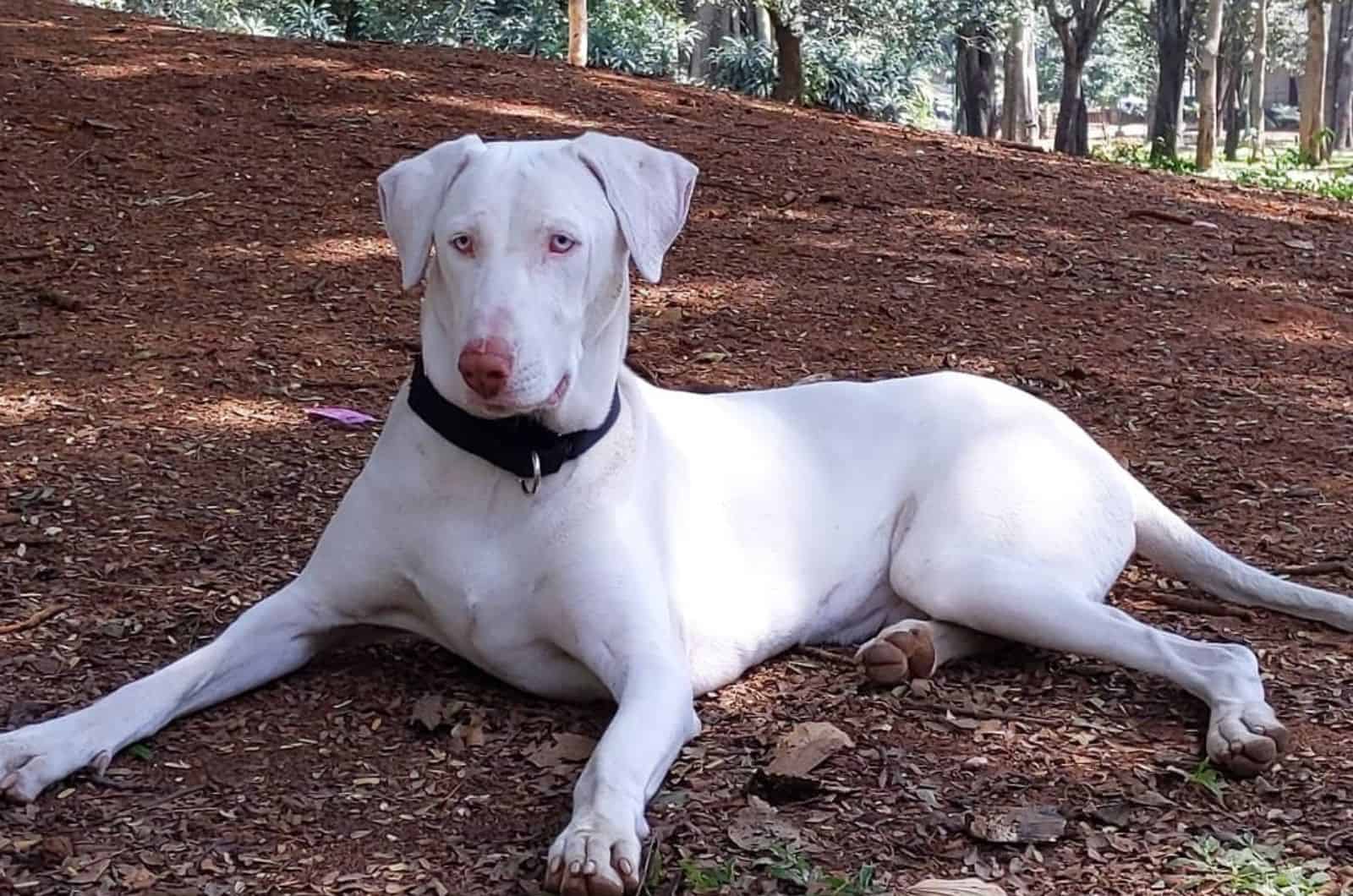The incredible India is home to some of the most agile and unique-looking dogs. ‘Dog’ in the Indian language translates to ‘kutta’, and it takes a special place in Indian culture.
Dogs play an important role in Hindu mythology. Hindus believe that dogs are sacred animals, messengers of the god, Yama, and gatekeepers of Heaven and Hell.
This is only one of many examples where Indian dog breeds are cherished and loved.
Although the majority of Indian dog breeds have never made it to being the most popular breeds in the United States, many of these incredible dogs can be seen in homes of pawsome dog owners.
Let’s dive into the world of mesmerizing Indian dog breeds!
1. Kombai
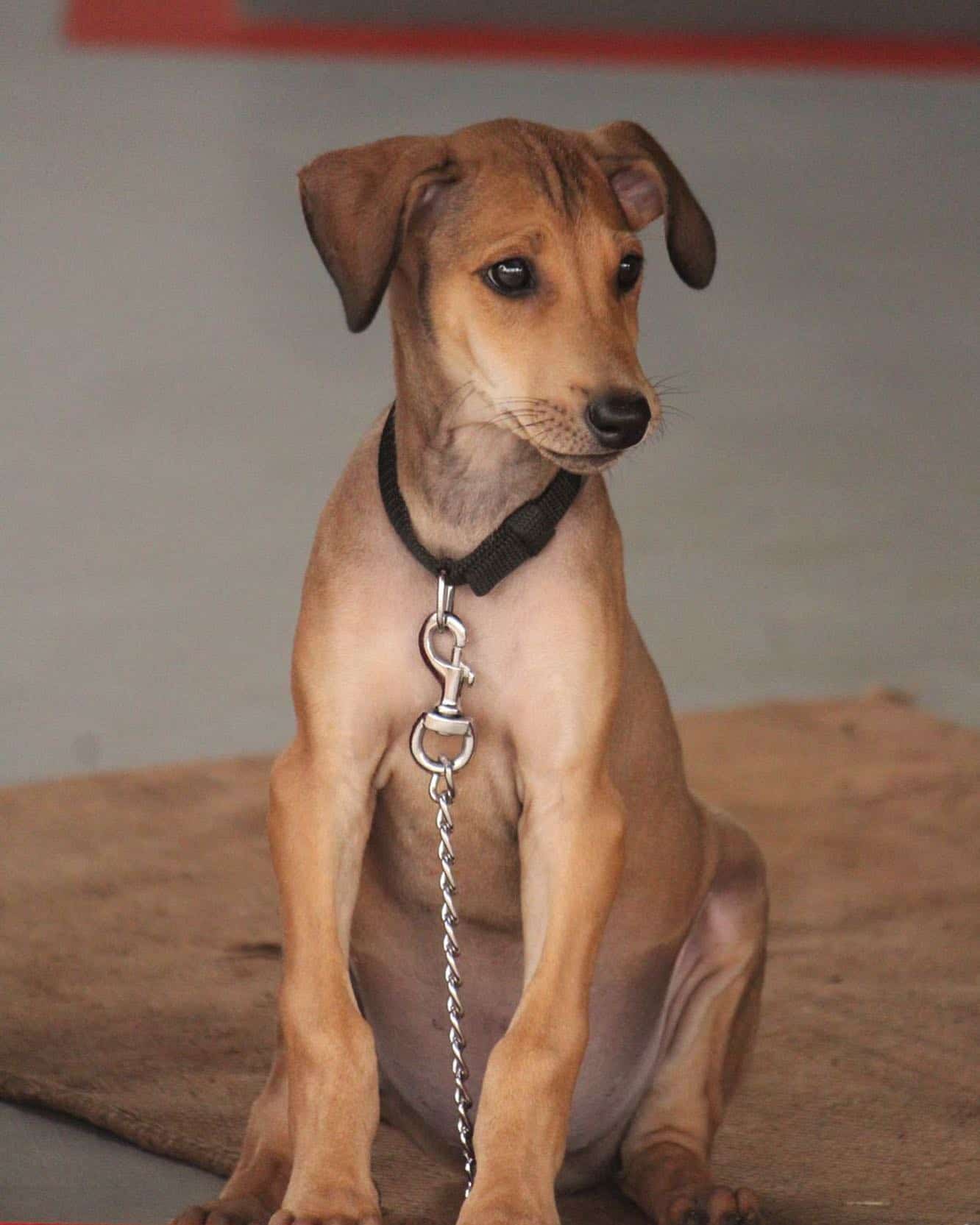
Photo from: @vetta_naai
Meet the first Indian dog breed on our list — the mighty Kombai. Its neat name adds to its cool appearance. The Kombai dog will surely stay in your memory for a long time. Let’s learn more about this wonderful dog breed.
History
The Kombai dog got its name after the town of Kombai, which is located and has its roots in the Tamil Nadu province, in South India. This dog is also known as the Kombai Boarhound, the Indian Terrier, and the Polygar dog.
When it was first developed, the Kombai dog was trained to be a hunting dog and a working dog. It showed impeccable hunting skills, and its agility was out of this world. There was no obstacle a Kombai dog couldn’t overcome.
The status of the breed has been the subject of conflicting reports; some from the 1960s claimed it was well-liked, and its numbers were rising, while others from the same decade claimed it was almost extinct.
Nevertheless, up to this day, the Kombai remains a vigilant hunting dog that is well appreciated in all regions of India.
Appearance
With a lean and powerful body that stands over 28 inches tall, the Kombai is an agile and athletic dog that grabs all of the attention. Although they are labeled as Indian Terriers, Kombais don’t look like any of your average terrier dog breeds.
Kombai dogs inherit a short, smooth coat that is usually colored in red, golden, or brown shades. Its coat is colored in a lighter shade that spreads across its back and chest. If we take out the characteristic black mask, the Kombai’s coat color is similar to the popular Labrador Retriever color.
Most Kombais inherit dark eyes, but there are individuals that see the world through beautiful golden-colored eyes. A Kombai’s ears are medium length, and their tips are bent over.
A significant marking is the black mask that is located on the Kombai’s muzzle. Their muzzle is elongated, but not as much as those in sighthounds.
The tail of the Kombai breed is long and progressively narrowed toward the end, and it is carried curled over their back.
Temperament
There is quite a lot to say when it comes to a Kombai’s temperament. These dogs are known as fierce, brave, and incredibly energetic. But, Kombai dogs are also known to be very reserved around strangers, and extremely territorial towards other dogs.
They have a reputation for killing any invaders, whether they are human or animal.
The Kombai usually chooses one person that it will love and protect. Therefore, the Kombai doesn’t necessarily make a good family dog. However, if you’re looking for a superior personal security dog, the Kombai is the perfect choice.
Since the Kombai breed is endangered, and its popularity has decreased, it is challenging to find a purebred Kombai.
2. Chippiparai
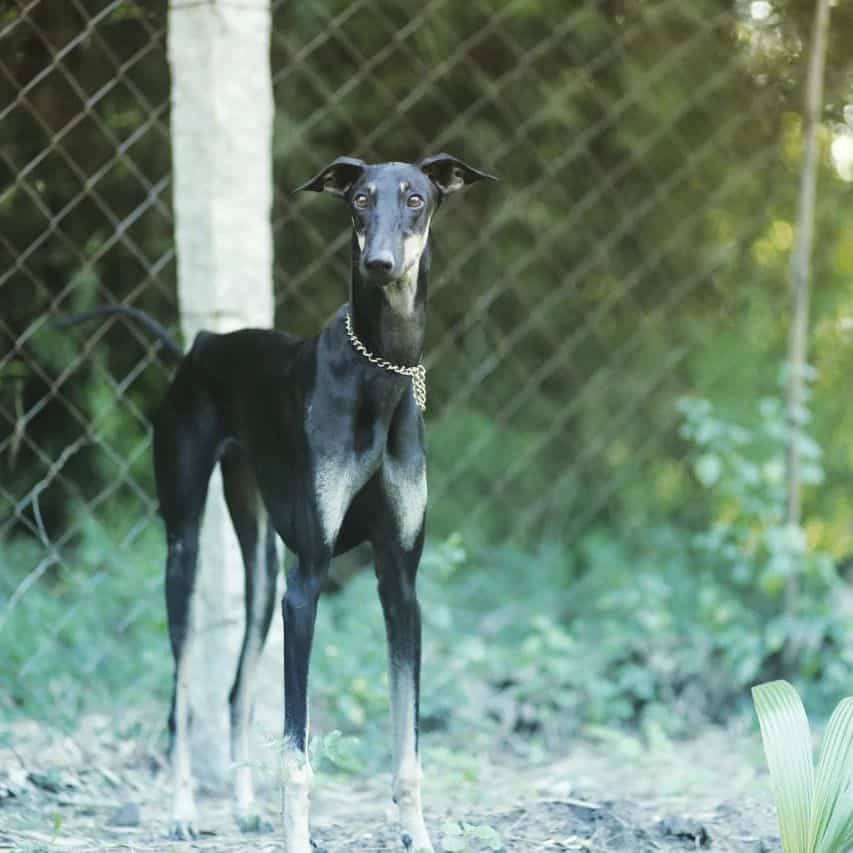
Photo from: @lucky_.the_.kanni
Chi-ppi-pa-rai! A fun name for a fun dog! Once you see a Chippiparai, you will definitely fall in love with its sleek body, elegant posture, and amazing personality.
If you haven’t heard about this Indian dog breed, now is the perfect chance! I guarantee that you will adore the Chippiparai’s appearance and temperament.
History
The Chippiparai has a rather royal history. This Indian dog breed, also known as the Kanni dog, originates from royal families of the Tamil Nadu province. On one hand, it served as an excellent hunting dog, while on the other, the Chippiparai was kept as a royal symbol and served as a companion dog as well.
Chippiparai dogs were primarily used to locate and kill their prey, which included deer, wild boar, and hare.
However, their noble appearance moved them from hunting grounds to dog shows. Nowadays, the Chippiparai breed is still beloved by the Indian folk and relatively easy to find. But, Chippiparais are very rare in the United States.
Appearance
The medium-sized Chippiparai are undoubtedly gorgeous! The best way to describe a Chippiparai’s appearance is to compare it with a popular sighthound dog breed, such as Greyhounds and Salukis.
The Chippiparai dog inherits a colorful, short coat that comes in silver, gray, and fawn, which are similar to those of the Greyhound dog breed. Depending on the dog’s coat color, their eyes may come in lighter shades.
A curving, slim tail is also one of the specific Chippiparai appearance traits. Like its sighthound cousins, the Chippiparai dog has quite a long muzzle to show!
The average height of adult Chippiparai dogs is between 20 and 25 inches for females, and between 26 and 27 inches for males at the withers.
Temperament
Chippiparais are intelligent and devoted dogs that are known for their family loyalty. While they are not unfriendly, they can appear a little reserved at first. Don’t worry – this is simply the Chippiparai taking his or her time to get to know you.
They are generally calm dogs, with one notable exception: this breed is known to frequently imprint on one person, and then devote the rest of their life to that individual.
They can even become overly protective of “their” person, becoming suspicious and even hostile to others. As with most breeds, this trait is easily managed through early socialization with a variety of people.
3. Kumaon Mastiff
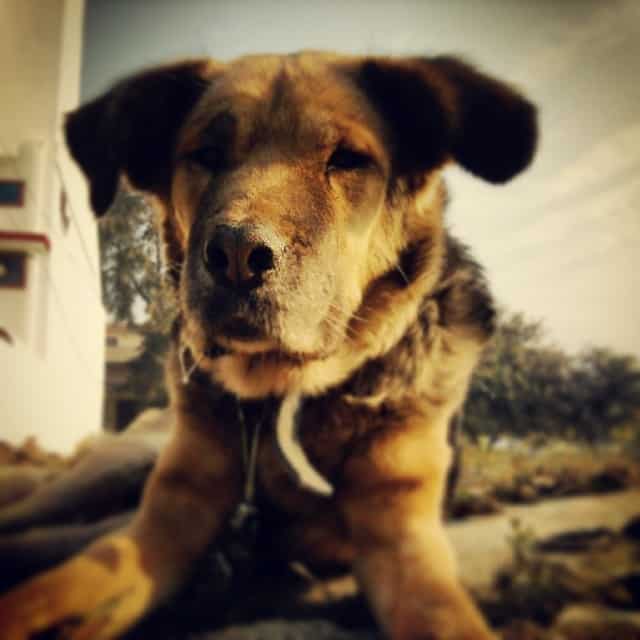
Photo from: @ankittomarmusic
You have probably never seen a more unique Mastiff than a Kumaon Mastiff. As its name implies, the Kumaon Mastiff belongs to the mighty Mastiff-type dog breed.
Mind you, the Kumaon Mastiff is not a Mastiff mixed breed.
What makes the Kumaon Mastiff different from the rest of its Mastiff counterparts are its huge body folds that are specifically located on its face and neck area.
History
We are not 100% sure where this large dog originates from, but most paw lovers believe that the Kumaon Mastiff comes from the Uttarakhand state of India.
Experts have also speculated that this animal descended from the large, solidly-built Molosser dog breeds, but another group of experts believes that this dog is more likely to be a distant cousin of the Indian Mountain dog breeds.
Some historians believe that the conqueror, Alexander the Great, introduced this breed to the Indian subcontinent around 300 BC.
Despite all of these arguments, there is no documented evidence to back up these beliefs. Despite the fact that it is a vulnerable breed, it has yet to receive official recognition from any of the kennel clubs.
Appearance
The Kumaon Mastiff reaches up to 30 inches in height, and it can weigh anywhere between 150 and 180 pounds.
It is said that Kumaon Mastiffs resemble old Great Danes in appearance. When we look at the Great Dane growth chart, it is clear that these two dog breeds are similar in terms of height and growth.
However, Kumaon Mastiffs are more bulky and wrinkly than Great Danes. Their body is strong-boned, and muscular. Their chunky large neck is what makes the Kumaon Mastiff’s appearance so intimidating and powerful.
Their coat is soft and short, and it comes in white and brindle (ranging from dark to light shades). Most Kumaon Mastiffs inherit the Bullmastiff’s colors. They also come with white markings and patterns.
Temperament
The Kumaon Mastiff is a fearless giant that is often referred to as an aggressive guard dog. But, this is a common misconception.
The truth is that the Kumaon Mastiff inherits a strong protective instinct, which some people define as aggressive behavior.
When it comes to its destructive behavior, the Kumaon Mastiff can develop behavioral issues if it doesn’t have a job to do. This is why they need to be introduced to early socialization as young puppies. Socializing an aggressive dog might take more time, especially with an older Kumaon Mastiff dog.
Moreover, Kumaon Mastiffs always need mental stimulation and physical activities. Training sessions that are assertive and strict from a young age can make them gentle and sweet-natured in general.
The Kumaon Mastiff is just a gentle giant that is extremely loyal to its owner and family. That being said, it will do its best to protect its human pack. These big fellas prefer to be with family members. Kumaon Mastiffs make just as great of guard dogs as Cane Corso and Rottweiler dogs.
4. Rampur Greyhound
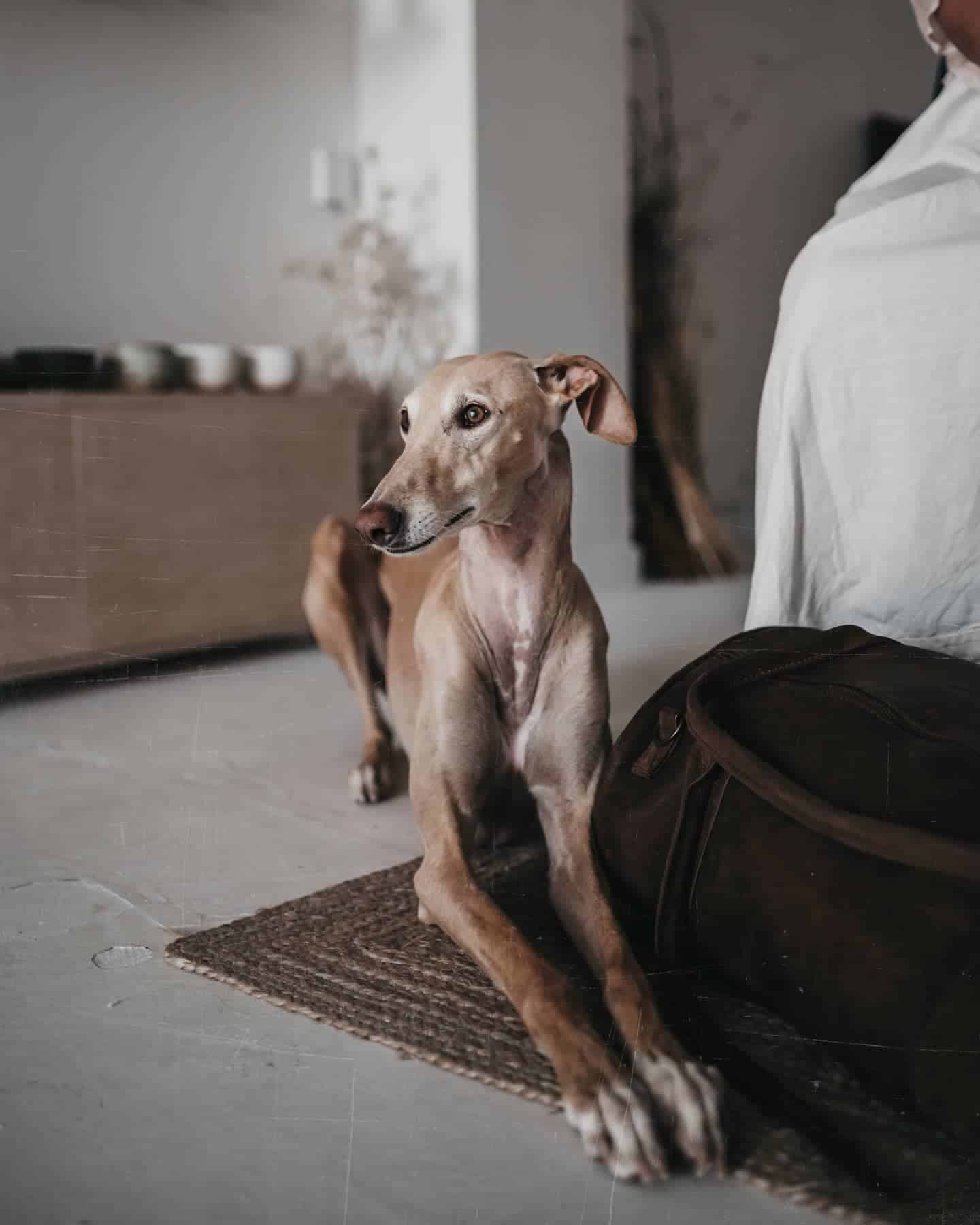
Photo from: @mestizaa
Sleek, muscular, elegant, and extremely athletic — the Rampur Greyhound is one of the fastest native dogs from India.
If you are a fan of the Greyhound dog breed, then the Rampur Hound might pique your interest!
History
Rampur Greyhounds originate from Northern India (somewhere between Delhi and Bareilly), and they have been around for approximately 300 years.
Here’s a fun fact about the Rampur Greyhound’s speed – these Indian sighthounds are known to be one of the fastest dogs in the world, with speeds exceeding a whopping 40 mph!
This is why Rampur Greyhounds were primarily used for hunting large animals (wild boar, panthers, leopards, and jackals) and protecting livestock.
Because the Maharajahs were no longer in power, the breed fell out of favor in 1947. This shift in power had an impact on the breeding of the Rampur Greyhound.
Nowadays, there are Greyhound breeders in the U.S. who either develop these pooches or provide more information on where to get purebred Rampur Greyhounds.
Appearance
The Rampur Greyhound resembles Arabian Greyhounds in appearance, with a tall, sleek build, a long, muscular neck, a curved back, and a deep-set chest. Because of its large size and deep chest, the Rampur Greyhound is prone to health problems like Gastric Dilatation and Volvulus.
With long and flexible legs, coupled with flexible paw pads and toes, the Rampur Greyhound has no trouble balancing itself while running mega fast!
The Rampur Greyhound’s remarkable appearance features a wider skull than what we see in most other sighthounds. This physical feature gives it a fuller face. Its fur coat is short, like the rest of its body, with a tapering tip with a slight curve.
This breed has a unique eye placement that allows them to have 260 degrees of vision – a trait shared with Chippiparai dogs.
The tail of the Rampur Greyhound is quite long, accounting for roughly two-thirds of its length. With such a long tail, there won’t be any problem finding out what the Rampur Greyhound’s tail position means!
Temperament
Rampur Greyhounds are typically laid-back and shy dogs that are often described as one-man dogs.
They have a lot of energy, so they will pay more attention to humans rather than sleeping all day.
Rampur Greyhounds are quite big, and they run fast, so they can easily knock over small children. Because these dogs were designed to hunt small animals, Rampur Greyhounds inherit a strong prey drive.
This is why Rampur Greyhounds require early socialization and obedience training. A Rampur Greyhound puppy should also frequently be introduced to new canine friends.
When they play with other dogs, they like to bite each other’s necks and butt their chests together!
5. Rajapalayam
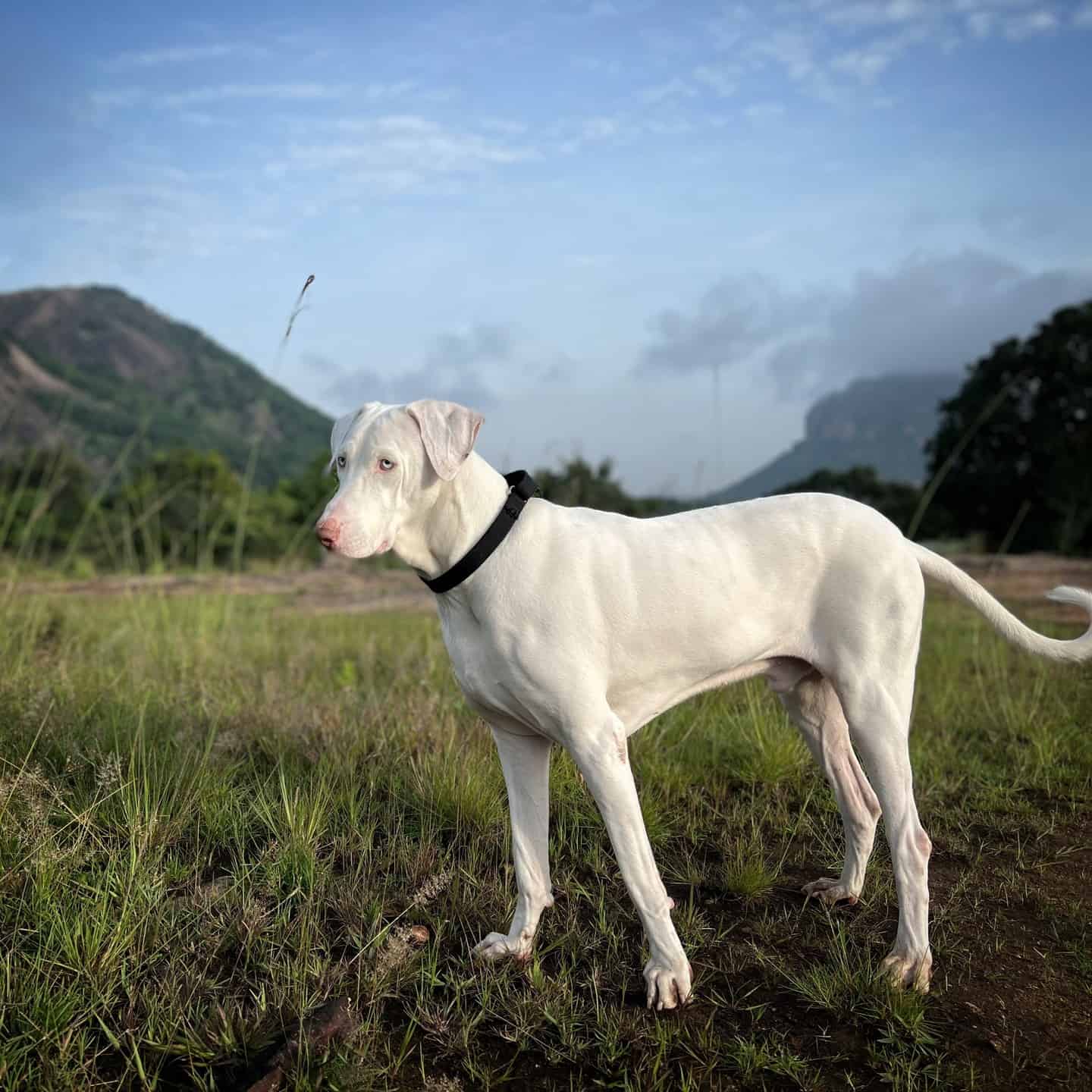
Photo from: @vali.dog
The striking Rajapalayam dog will leave you breathless! This white to cream-colored sighthound is, well… a rare sight to see!
Let’s see what makes the Rajapalayam so special.
History
Indian dogs were praised all over the world for their hunting abilities in ancient times. They were exported to several empires, including Rome, Egypt, and Babylon.
The Rajapalayam dog breed was identified in the Indian subcontinent in the 18th century.
They were bred in Tamil Nadu during the Nayak dynasty, and were known to be fiercely loyal in addition to being excellent guard dogs.
Villagers in the area have used them to protect agricultural crops, livestock, and farm produce.
Appearance
Rajapalayam dogs are large sighthounds, standing over two feet tall, and weighing around 70 pounds on average.
What makes them stand out among other sighthounds are their heavy bones and large head.
In addition to a bigger head, the Rajapalayam dogs inherit a broader snout. One of the cutest physical traits are the Rajapalayam’s triangular floppy ears that sit high on the sides of its head and fold downwards.
Not only are their ears floppy, but they are also wavy and sometimes curly. I’d say that their ears are similar to the female Cocker Spaniel. But, their cuteness doesn’t end here!
Rajapalayam are dogs with a pink nose! Following this specific physical trait, their coat is mostly solid white, short, and smooth. Naturally, just like all pure white dogs, the Rajapalayam dogs inherit pale and pinkish skin.
Due to the fact that they are solid white with a pink nose, Rajapalayam dogs are often mistaken for albino dogs.
Rajapalayam dogs inherit a unique set of dark brown eyes that can also come in blue, similar to Husky eye colors.
Temperament
Generally speaking, Rajapalayam dogs grow into loyal and affectionate canine companions that are very attached to their owner.
But, there is another side to the bubbly Rajapalayam dog’s behavior.
Due to each Rajapalayam inheriting a unique personality, some of them might not get along well with small children. I guess younger kids are just too loud and touchy for Rajapalayam dogs!
Besides that, a Rajapalayam’s cautious behavior makes them wary of strangers, so they make excellent watchdogs. However, this can be troublesome if they react negatively towards family members and friends.
This is why the Rajapalayam dog breed requires early socialization. Not only will early socialization help Rajapalayam puppies get along with their canine and human friends, but it will also help them achieve their maximum potential!
6. Pandikona
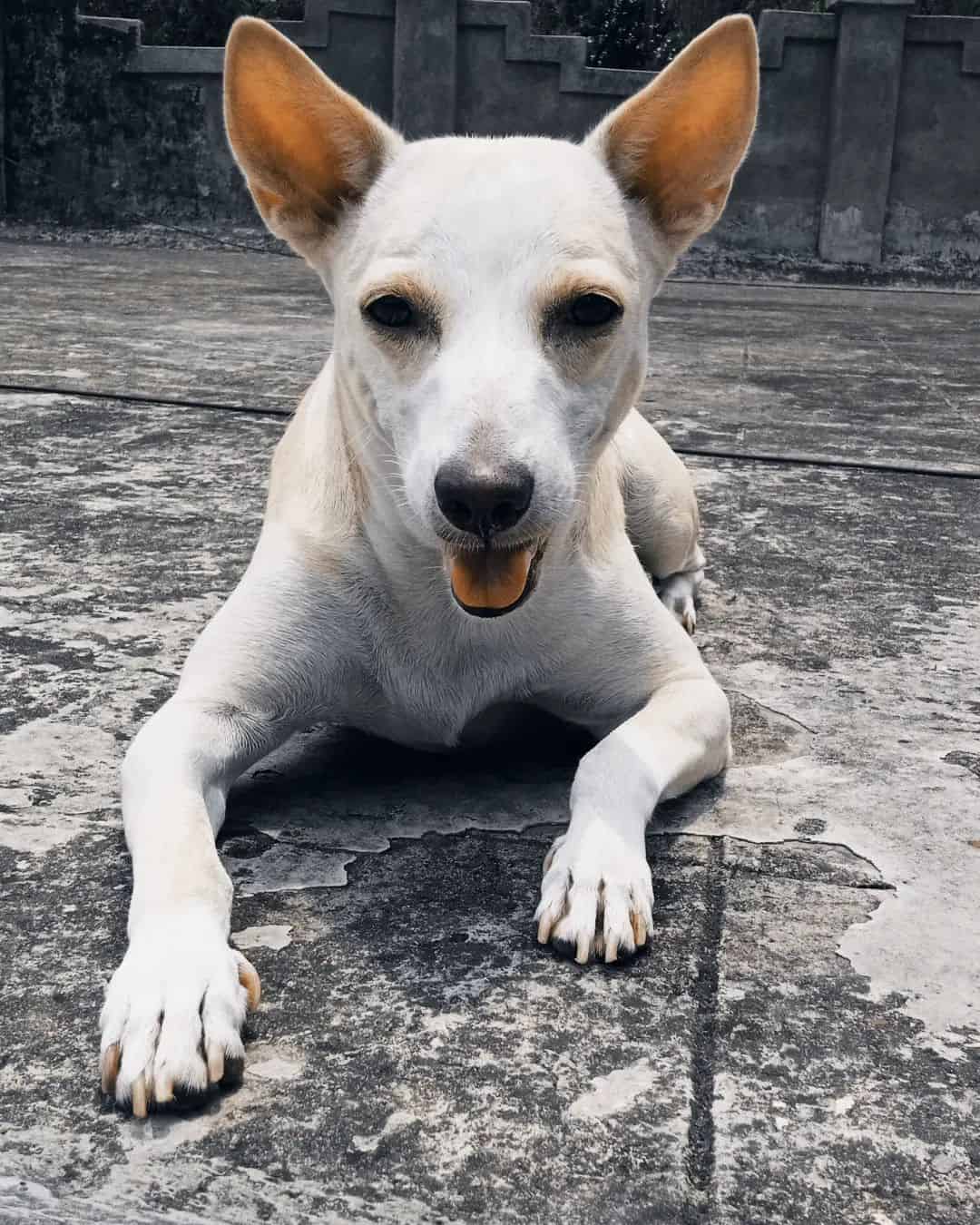
Photo from: @_pawsierra_
The first time I heard about this Indian dog breed, I thought it looked like a panda. But, I was definitely wrong. The Pandikona closely resembles a Doberman Pinscher. However, it is still very different.
Let’s learn more about the Pandikona dog breed.
History
It’s best to start off with a fun fact! Pandikona dogs are named after the Pandikona village in India, and they can only be found there! They live in India’s Kurnool district, which has very dry air and little rain.
Nobody knows when the first Pandikona dogs were born because they bred on their own, and are very independent. But, they have been around for so long that they learned to live with people, and nowadays, they act as village guard dogs.
A not-so-fun fact is that the Pandikona dog is such a rare dog breed that it is on the verge of extinction.
Appearance
Due to the fact that Pandikona dogs physically resemble European Dobermann Pinschers, they quickly acquired the name “Indian Doberman”.
This is quite understandable, though – Pandikona dogs resemble Doberman Pinschers in appearance because they inherit large, pointy ears that fall downwards, and a medium-sized muzzle.
Pandikona males can reach a height of 26 inches, while females can reach a height of 24 inches. Their size and development is similar to the Doberman Pinscher’s growth.
A Pandikona’s weight varies according to the dog’s build, and there is little to no information about it, but we are guessing that they weigh somewhere between 70 and 80 pounds.
The Pandikona, on the other hand, comes in nearly every color. Colors range from fawn to black, with white patches in between.
A super cute Pandikona feature is its tail, which slightly curls upwards, just like in the Japanese Spitz and Samoyed dog breeds!
Temperament
The Pandikona are friendly and good-natured, making excellent companions for individuals or families. They require socialization and training from a young age, but their territorial instincts are unavoidable. Fortunately, most owners have discovered these instincts to be extremely useful.
Pandikonas are not the most playful dogs, but they can get used to lots of human interaction.
They like to stay outside. Having said that, most Pandikonas spend time as independent dogs, and they exhibit the all-natural rolling on dead animals dog behavior.
Pandikonas are not dogs to play with. An attack will occur quickly and with little warning. As a result, they’re thought to be ideal for defending a village, but less so for new interactions with unknown people.
7. Mudhol Hound
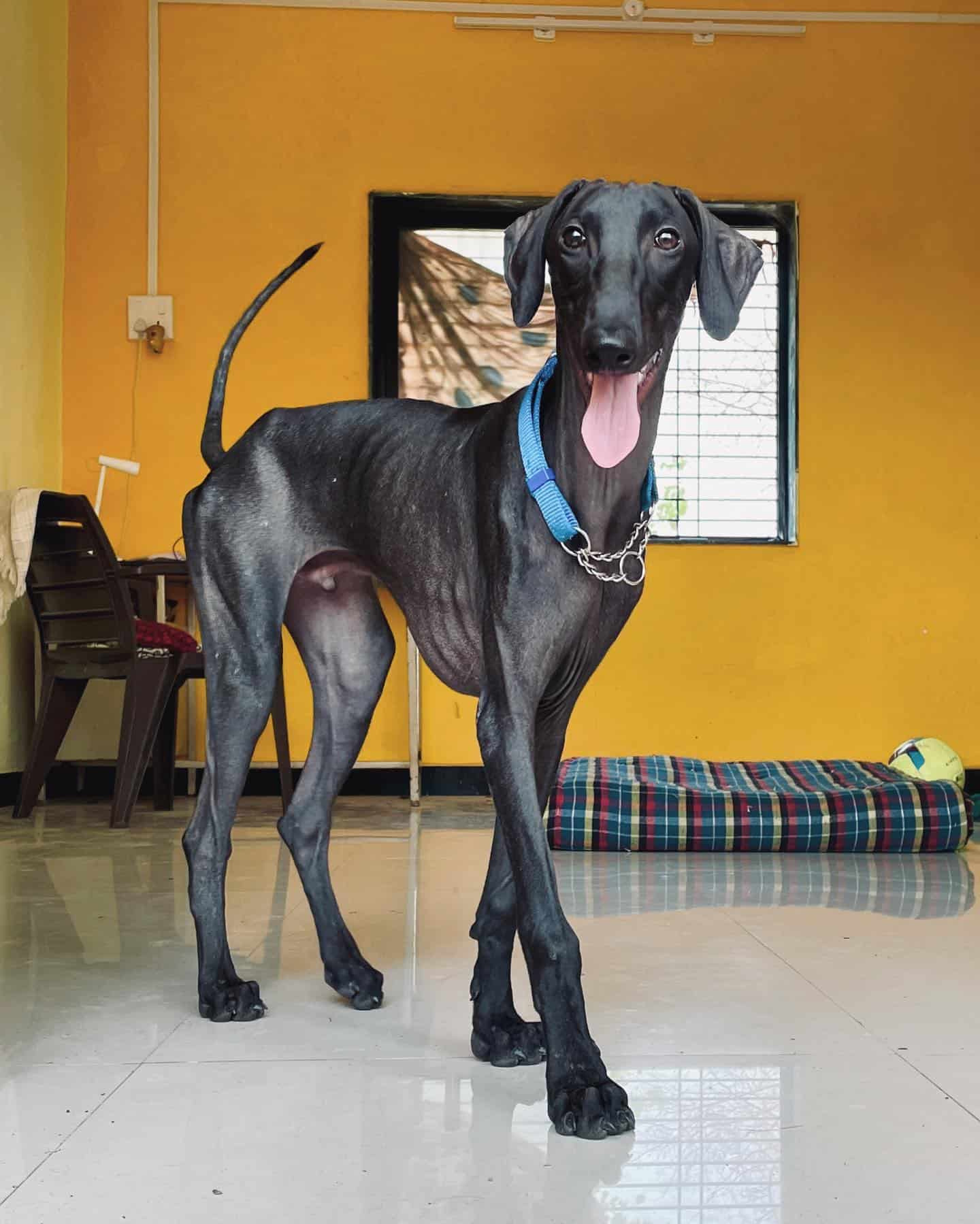
Photo from: @pushpa_caravani
Meet another sighthound originating from India — the elegant Mudhol Hound. This large dog is very slim and athletic. Its build helps the Mudhol Hound run at fast paces.
Besides being an extremely fast dog, the Mudhol Hound is a loyal canine companion that loves to interact with its family members.
History
The history of the Mudhol Hound breed goes back many years ago to a region called India’s Deccan Plateau.
The Deccan Plateau region includes parts of Karnataka, Maharashtra, and, to a lesser extent, Andhra Pradesh.
It is believed that the Mudhol Hound breed was first introduced into India by mercenaries and traders traveling in caravans from various parts of Asia (hence, the name Caravan Hound).
Appearance
An adult Mudhol Hound stands around two feet tall, which makes it among the tallest dog breeds. In addition to its height, the Mudhol Hound weighs between 45 and 90 pounds. Its body is athletic and muscular, with long and elegant limbs.
Caravan Hounds inherit large, piercing eyes that are oval in shape, and come in varying shades of brown and hazel.
Mudhol Hounds are very bony, and some people might think that they are not eating well. But, don’t worry – that’s how Mudhol Hounds naturally look!
Temperament
Although Mudhol Hounds can be reserved at times, this behavior should not be mistaken for unfriendliness. Mudhol Hounds are so shy that they might want to hide and sleep under the covers!
Mudhol Hounds make excellent family pets, and form a special bond with one member of the family. Although these hounds are not suitable for younger children, they bond well with older children, and are warm and affectionate towards them.
Because of their high prey drive, your Mudhol may get along well with other dogs, but will not tolerate smaller pets.
The Mudhol Hound breed is full of energy, and will probably become obsessed with balls and other dog toys! It’s important to keep your Mudhol Hound busy with regular exercise. Daily physical activity will help maintain agility and provide mental stimulation.
Having said all of this, the Mudhol Hound isn’t the best dog to keep either in a big or a small apartment.
8. Gaddi Kutta
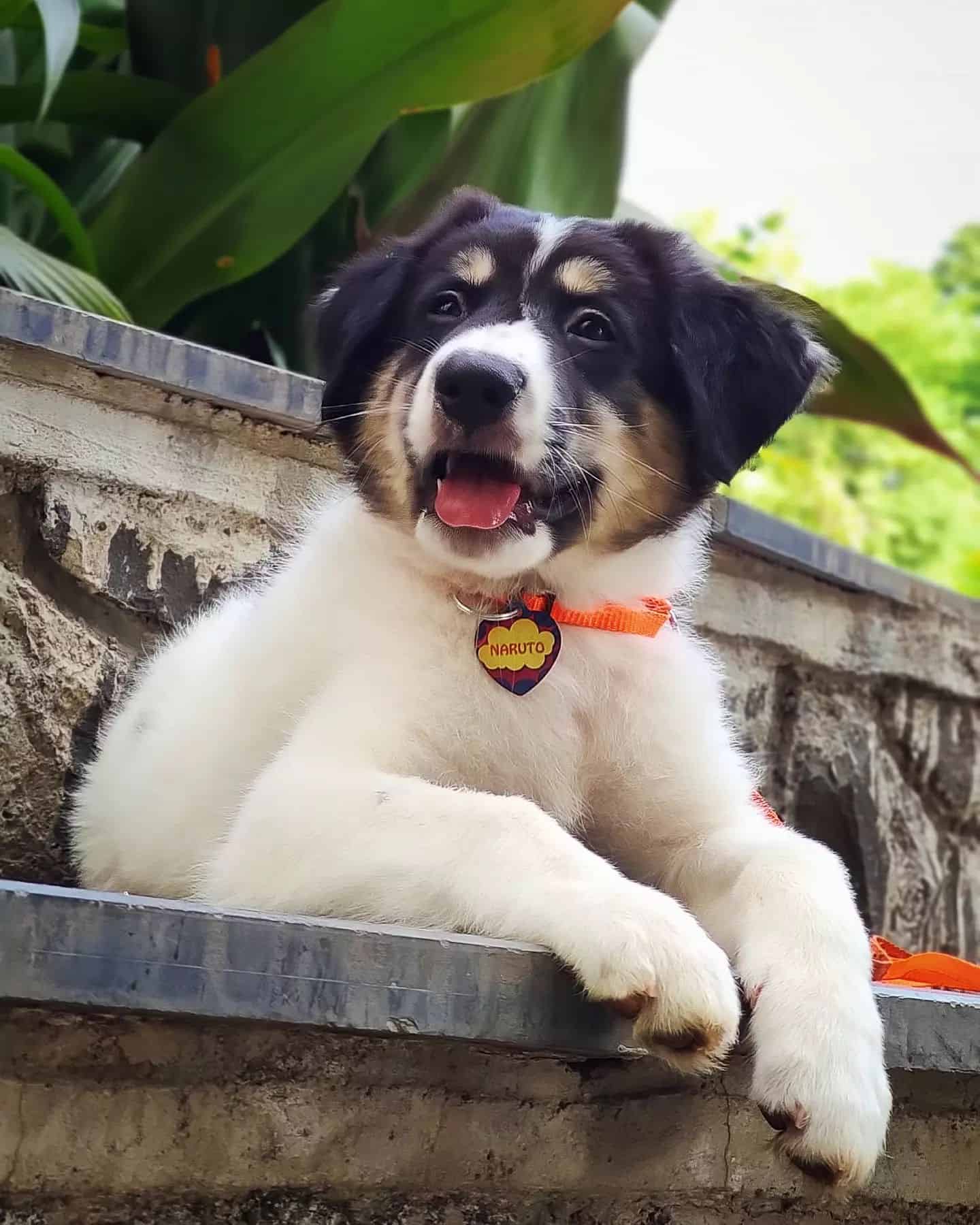
Photo from: @naughtynaruto22
Looking at the Gaddi Kutta dog breed, the first thing that comes to my mind is a long-haired Rottweiler! But, the Gaddi Kutta is fluffier than your average long-haired dog.
Let’s see what this large dog has in store for us!
History
The origin of the Gaddi Kutta is kind of mysterious. They are Mastiff-type dogs, and most believe that Gaddi Kuttas are a cross between Himalayan wild dogs and Tibetan Mastiffs.
According to the Indian Kennel Club, the Gaddi Kutta is not a purebred dog.
Appearance
The Gaddi Kutta is a remarkably large dog, with a muscular body that is built for power and endurance. When compared to the actual Tibetan Mastiff, the Gaddi Kutta is not as bulky.
Their large body is proportional to their large skull, deep chest, and straight back.
Their dense undercoat combined with a thick outer coat makes the Gaddi Kutta one of the fluffiest dog breeds!
The Gaddi Kutta’s coat length is different on different parts of its body. It is longer on the chest, legs, and tail, and the reason behind that is to protect them from the unpredictable Himalayan weather conditions. Cool, right?
Just like most Cane Corso and Rottweilers have their ears cropped, the Gaddi Kutta often undergoes this aesthetic procedure.
Temperament
The Gaddi Kutta is a fluffy, gentle giant whose loyalty towards its family is indescribable. This calm breed of dog is brave and territorial, which makes it the perfect guard dog. Besides that, the Gaddi Kutta’s strong work ethics make it an incredible working dog.
In fact, people in the Himalayas often use Gaddi Kutta dogs to help them with chores and the transportation of goods.
Gaddis are intelligent dogs that show incredible herding skills. These dogs are so large and intimidating-looking that they are capable of protecting the whole village from bears, wild boars, and leopards.
Due to its large size, the Gaddi Kutta is probably not a good breed to have around small children because it can unintentionally knock them down during playtime. If you are interested in the Gaddi Kutta dog breed, try searching for Tibetan Mastiff breeders in the U.S. who may breed these gentle giants!
9. Himalayan Sheepdog
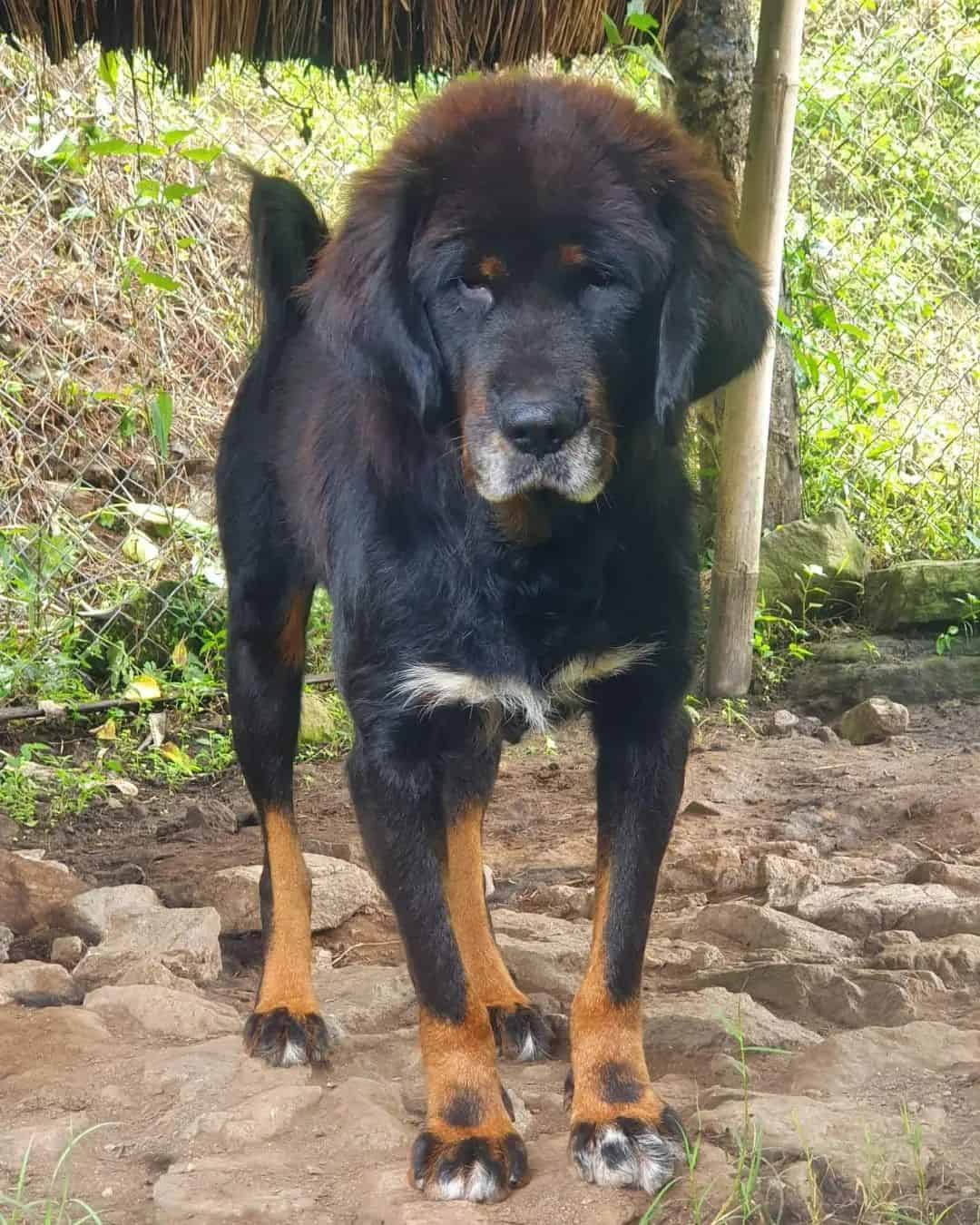
Photo from: @kanchenjunga.bhotekukur
The Himalayan Sheepdog is a true representative of strong and fluffy mountain dogs. Its appearance is mind-blowing, and its intelligence is even more remarkable!
Himalayan Sheepdogs are known to inherit incredible guarding and herding skills that come in handy to people living in villages and on ranches.
History
This Indian dog breed is also thought to have existed in those areas since ancient times. Himalayan Sheepdogs are agile and territorial. This particular personality got them working as either guard dogs or herding dogs.
The Himalayan Sheepdog was commonly used to herd and protect cattle from predators.
The breed has also been used to hunt large game throughout its history, particularly in the harsh terrains of its region.
Nowadays, Himalayan Sheepdogs can only be found within the borders of India and Nepal.
Appearance
The Himalayan Sheepdog is best described as big, solid, sturdy, and a little intimidating. A natural protector of man and beast, the Himalayan Sheepdog inherits a strong body that can weigh up to 90 pounds.
Standing up to 28 inches tall, the Himalayan Sheepdog is one helluva giant! No wonder why these puppies are always hungry! They grow rapidly, and reach their full size when they turn 18 months old.
Himalayan Sheepdogs inherit a deep chest and a strong neck that give them the strength to take on large predators. Their muzzle is pointed, and their jaws are powerful enough to break bones!
Himalayan Sheepdogs are fluffy giants that have most of their dense fur located around their neck, making them look like fluffy lions. Another remarkable Himalayan Sheepdog trait is its bushy tail that is curled upwards.
Temperament
These canines are energetic, intelligent, protective, and eager to please.
Due to the fact that Himalayan Sheepdogs grow quickly while acquiring incredible strength, they need early training and socialization. You seriously don’t want an aggressive dog of this size!
The Himalayan Sheepdogs herding instincts are to blame for their nibbling behavior when they are young puppies.
It takes lots of time and dedication to train a Himalayan Sheepdog, even though it is an intelligent pup. Its intelligence can lead to some stubborn and strong-willed behavior.
Himalayan Sheepdogs enjoy the outdoors and laying in the sun. They like to play fetch, and their favorite activity will probably be playing hide and seek!
Surprisingly, the “intimidating-looking” Himalayan Sheepdogs are big cuddle bugs! These enormous dogs will surely like to sit on your lap all the time!
10. Indian Spitz
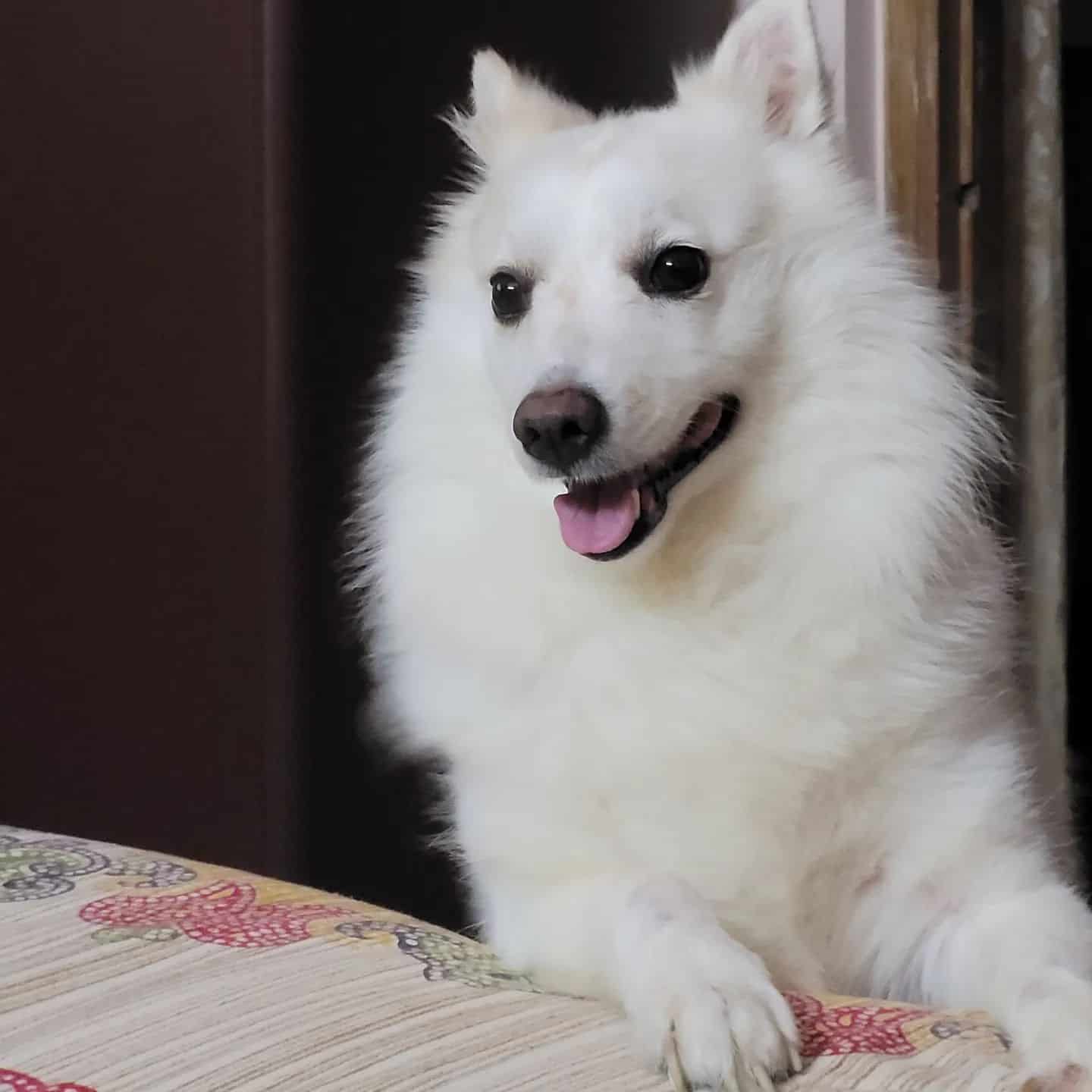
Photo from: @fluffysood
The Indian Spitz inherits a fluffy white coat, a fluffy, curled up tail, and foxy ears. It is very similar in appearance to other Spitz-type dog breeds.
Let’s see if the Indian Spitz dog is similar to its Japanese and German counterparts.
History
If you are familiar with Spitz-type dogs, then it’s easy to guess the origins of an Indian Spitz dog. The Indian Spitz originates from the German Spitz dog breed, and it was introduced to India back in the 19th century.
Back in the 1980s and 1990s, everyone wanted to own an Indian Spitz! At that time, it was a very unique purebred dog in the Indian dog market.
Despite their long coat and their northern genes, Indian Spitzes have become accustomed to Indian climates after many years of intensive research and selective breeding.
Appearance
While some might describe the Indian Spitz as a wolf-like dog breed, this small dog best resembles a white fox! Its gorgeous white coat is long, thick, and soft. This remarkable Indian Spitz trait puts it in the spotlight!
But, white is not the only coat color the Indian Spitz breed has to offer. These cuties come in solid colors ranging from milky white to dark black, and dusky brown.
Indian Spitz dogs inherit short legs, but not as short as in male and female Dachshunds. When it comes to its appearance, the Indian Spitz is no different from other Spitz-type dogs. It, too, inherits foxy ears and a curled tail!
Temperament
The Indian Spitz is a very clever pooch that loves to play and have fun! It is always alert, and it makes sure its owner knows when something is not right (this makes it a great watchdog). Trust me – the Indian Spitz will want to bark at nothing just to be sure.
Other than that, if you allow the Indian Spitz to believe it is in charge, it will become an unbearable barker. If it comes to this, you will want to show dominance to your dog in order to train and resocialize it.
The Indian Spitz is very trainable, and this dog can become an incredible family pet and adventure buddy. Indian Spitz owners should be consistent with training and socialization in order to raise a healthy and happy pooch.
Despite being so vocal and stubborn at times, the Indian Spitz usually gets along well with small children and pets.
11. Kaikadi
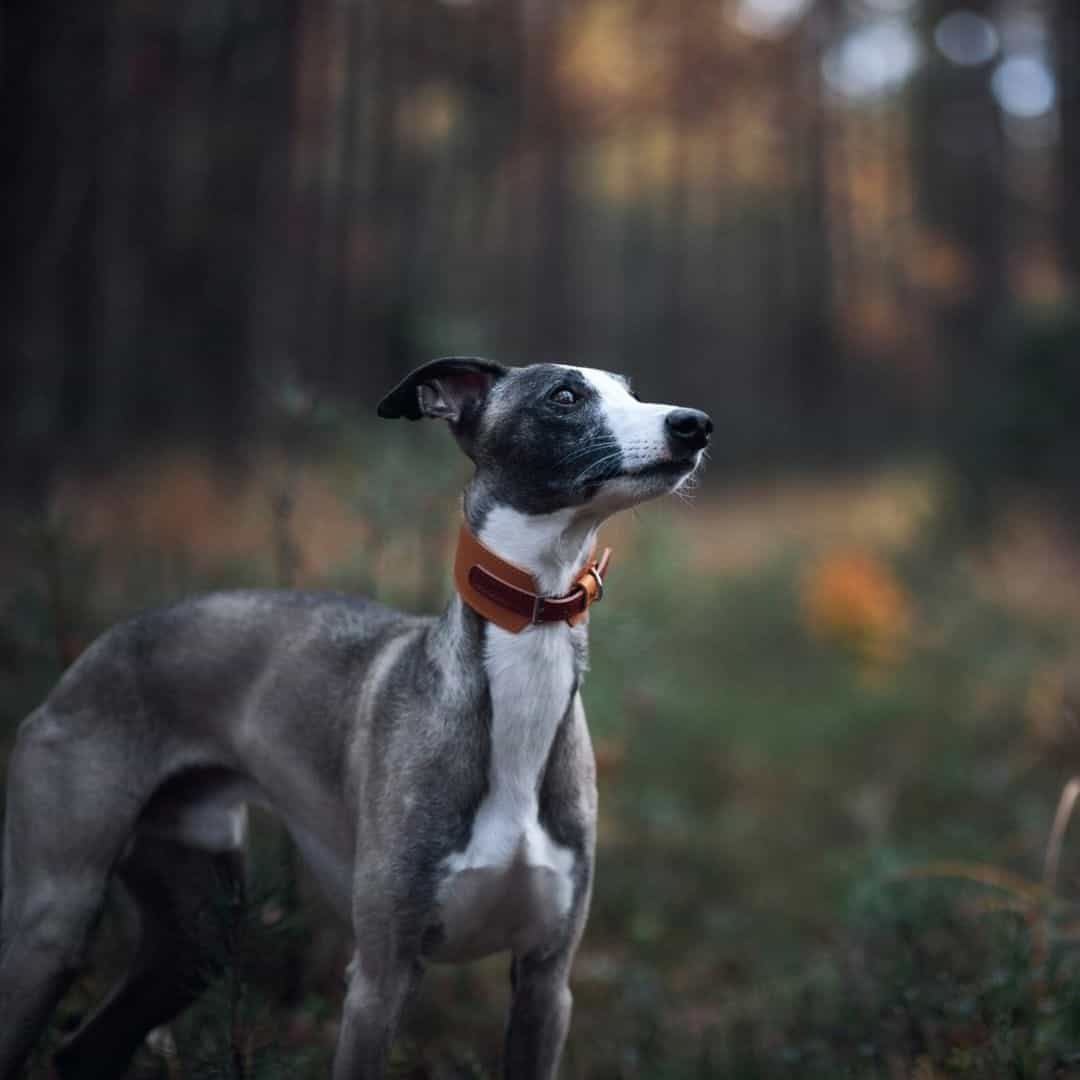
Photo from: @doghill.pl
Meet the Kaikadi – a well-known pup for its incredible speed. Fast as lightning, Kaikadi dogs are professionals at hunting small animals, such as rodents and lizards!
How about we say something more about this fun breed of dog?
History
The Kaikadi breed is named after a nomadic tribe in India, specifically the Maharashtra, and it is thought to originate from terrier breeds.
The original Kaikadi breed of dog has become difficult to locate over time. This is because the breed has interbred with stray dogs and Indian Pariah dogs for many generations.
Appearance
Kaikadi dogs are small, and are members of the sighthound dog breed that stand between 15 and 18 inches tall.
Their short coat comes in a variety of colors, with white, tan, and black being the most common.
The breed is wary of strangers, and works as watchdogs for their owners at night.
Temperament
The Kaikadi is a loving, alert, and energetic dog. It requires a lot of space for exercise, and it will not be the best dog for a small apartment. Besides its high energy levels, the Kaikadi dog can be fairly quiet and docile.
Having said that, the Kaikadi is quite sensitive. So, while it gets along well with children at home, it might not respond well to large families with a lot of new faces and loud children. Situations like these can cause a Kaikadi anxiety, which can turn into aggression.
The Kaikadi is a dog that will need to be trained and socialized if you want it to be obedient and get along with children and other pets in the house.
12. Bully Kutta
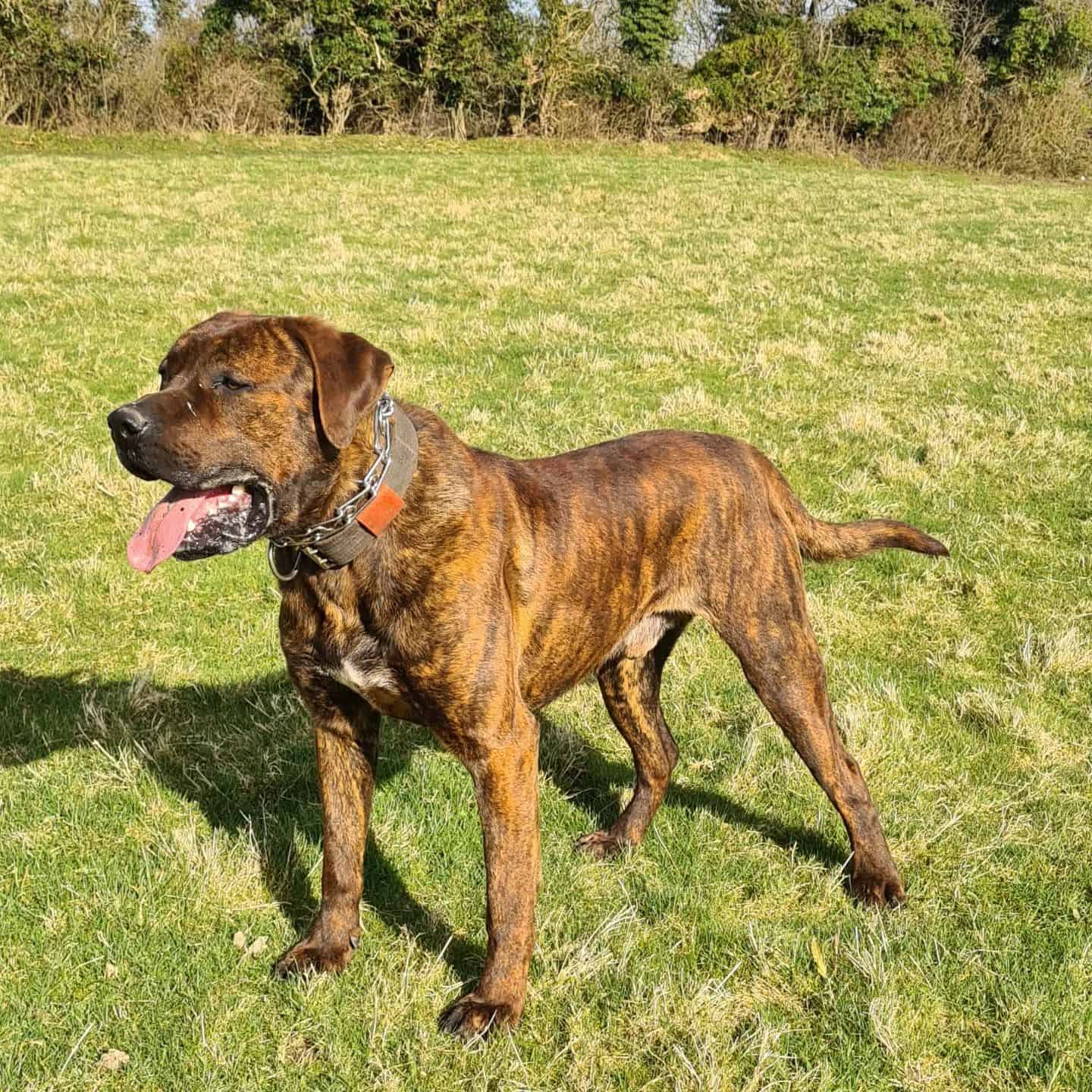
Photo from: @keltickennels
Is this Indian dog breed really a beast? There’s only one way to find out!
History
The origin of the Bully Kutta is not entirely clear. It is believed that the Beast of the East has its roots in either the medieval Sind region or in Madras’ Thanjavur and Tiruchi districts in the Indian subcontinent.
Back then, the Bully Kutta dog was favored by emperors and higher-ranked families. Although it was often used for hunting, the Bully Kutta was a great canine friend that everyone loved and appreciated.
The word “Bully” in the name is anglicized, and it is derived from Punjabi (the language spoken by people in Punjab, Pakistan). The word “Bohli” means “heavily wrinkled.”
And, as we mentioned earlier, the term “Kutta” means “dog”. So, Bully Kutta = heavily wrinkled dog!
Appearance
To begin with, the Bully Kuttas body consists of thick bones and strong muscles.
Just like Bulldogs, most Bully Kuttas inherit loose skin, particularly around their strong neck and powerful jaw. This loose skin around the Bully Kutta’s jaw makes this dog drool a lot.
With a low-maintenance short coat, the Bully Kutta is a great choice for paw lovers who find grooming a chore. Besides that, Bully Kuttas inherit beautiful Bulldog colors. However, they are almost always white, with occasional bicolor patterns.
Male Bully Kuttas usually grow between 30 and 34 inches tall, while females grow between 29.5 and 31.5 inches. Bully Kuttas are very big dogs, right?
The average weight of a full-grown Bully Kutta ranges between 150 and 200 pounds.
Temperament
Bully Kuttas are noble and intelligent pups.
With their keen senses of sight and smell, they make excellent guard dogs, protecting not only their own territory, but also their owner. However, the Bully Kutta puppy requires sufficient training and early socialization in order to form a bond with its owner.
Bully kuttas love to sleep the whole day! Despite their large size and intimidating appearance, Bully Kutta dogs are cuddlers that love sleeping close to their owner!
13. Kanni
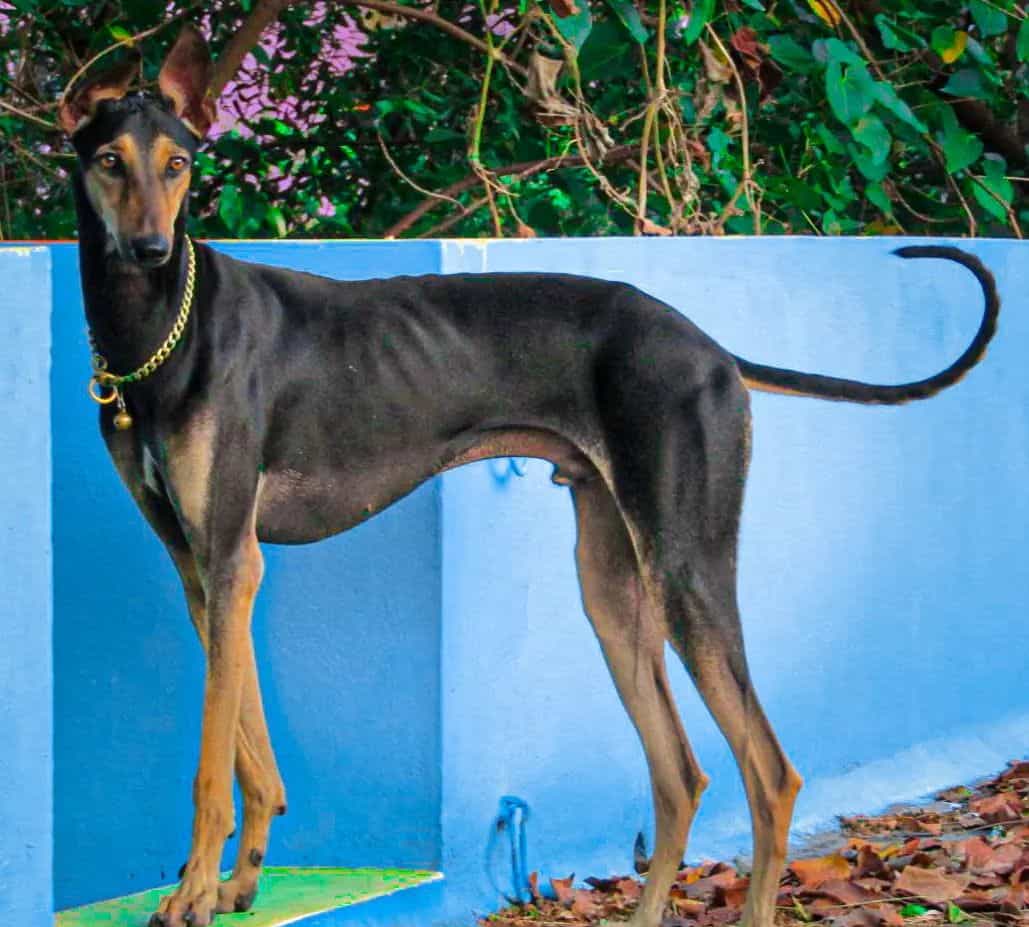
Photo from: @johny_the_kanni
Meet Kanni, a native Indian dog that made nobles go crazy for its elegant looks! The Kanni is one of the Indian sighthounds that plays an important role in village traditions.
Because of their involvement in weddings (as traditional wedding gifts), Kanni dogs are commonly referred to as the Maiden’s Beastmaster.
History
The Kanni originated in Southern India, and its name translates to “pure” in Tamil. Even nowadays, the Kanni dog breed is only found in Southern India.
You see, there is a reason why they were given this name. Throughout their history, Kanni dogs have proven to be the purest pups that would do anything for their owner because of their dedication and purity of heart in demonstrating their devotion to their owner.
Historically, Kannis were used as hunting and guarding dogs that showed incredible athleticism and agility.
Appearance
Kanni dogs inherit sleek and muscular long legs that help them reach high speeds!
Not only do their long legs serve for fast running, but they also make the Kanni dog look very elegant. Like all sighthounds, Kanni dogs inherit a short coat, and a long, but thin tail.
A Kanni must have a black and tan coat in order to be recognized by kennel clubs. Even if the other characteristics are identical, any other coat color would be considered a Chippiparai.
The fun thing about Kanni colors is that each color shade has a different name:
• Paala Kanni = an off-white Kanni dog
• Pottu Kanni = Kanni dog with brown spots
Kanni dogs inherit thin, floppy ears that fold downwards. Most pups have dark-colored eyes and a black nose.
Temperament
Kanni are generally reserved dogs. However, when it comes to their family, they are extremely loyal and protective.
The Kanni dog breed is very smart and trainable. However, some Kanni dogs are prone to being very stubborn and independent. They require a lot of exercise and quality playtime. Not to mention their amount of mental stimulation!
If a Kanni dog gets very bored, there is a chance that it will develop destructive behavior, and it might become restless, especially at night.
14. Vikhan Sheepdog
Ever heard of the Vikhan Sheepdog? It’s okay if you haven’t because this pooch is so rare that not many people have ever heard of it. This is why there is little to no information about this Indian dog breed.
It doesn’t help that this dog breed isn’t recognized by any Indian kennel club.
History
The Vikhan Sheepdog breed is thought to originate from Pakistan, specifically in the North-West Frontier Province near the Indian border. However, because this region is so close to Northern India, most people believe that the Vikhan Sheepdog originates from the Himachal Pradesh state.
But, Pakistan is generally credited for the breed’s development because they used and bred these dogs to protect livestock and hunt leopards. This is what kept the Vikhan Sheepdog breed going!
Appearance
Adult Vikhan Sheepdogs stand 26 inches tall, and they usually weigh up to 80 pounds.
Vikhan Sheepdogs are known for their short, but thick coat that come in solid brown, black, red, and fawn. However, some of these working dogs can be multicolored.
Temperament
While Vikhan Sheepdogs are a very intelligent breed, their breeding purpose can lead to them being quite protective and aggressive in some situations. This behavior has a lot to do with socialization and upbringing.
The Vikhan Sheepdog’s temperament is heavily influenced by its use as a livestock herder and a working dog. Naturally, it is very trainable, and it can be taught very complex things because it picks up commands quickly.
Vikhan Sheepdogs get along with other dogs, but owners must be cautious about where, when, and how to introduce them.
15. Indian Pariah Dog
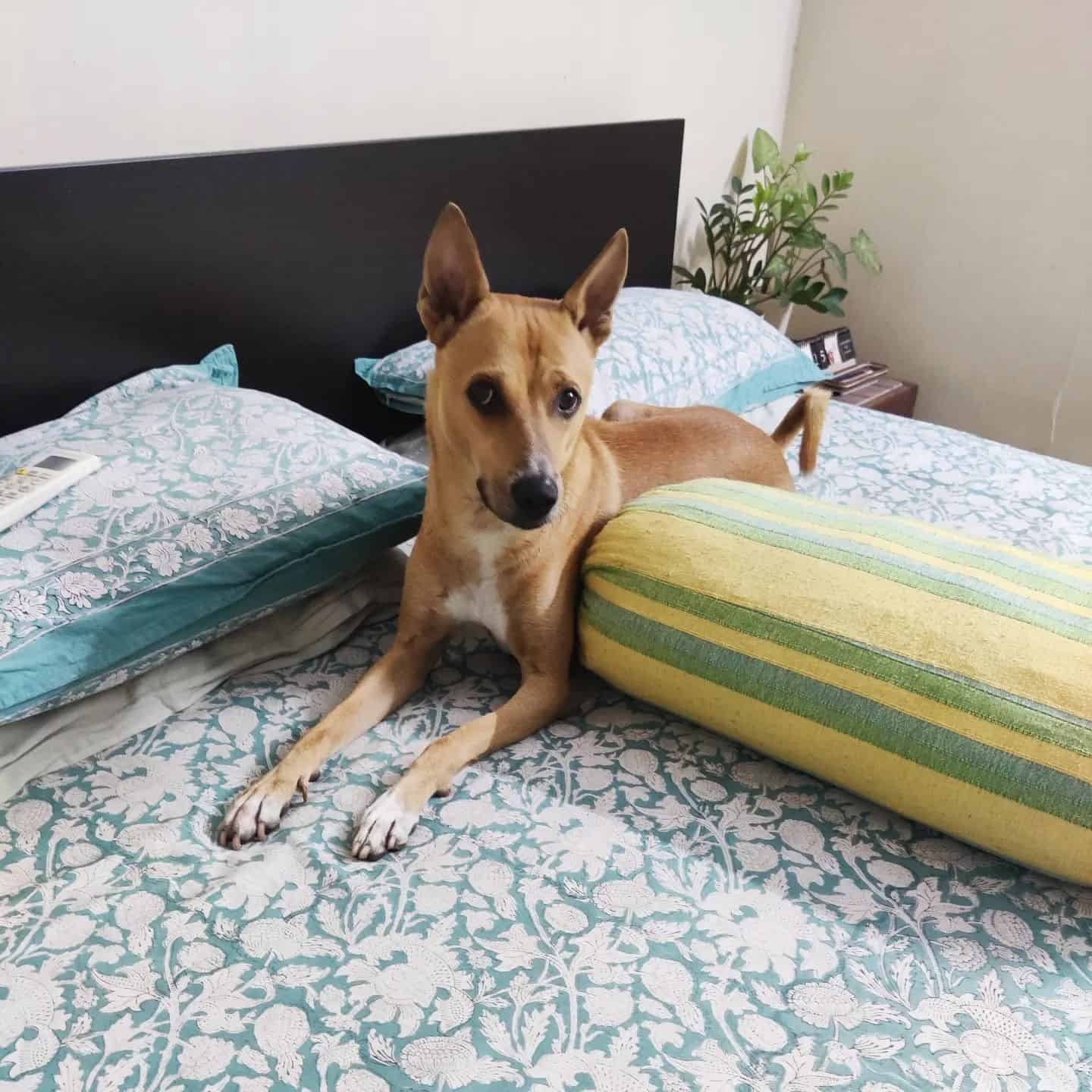
Photo from: @basudatta
If you haven’t heard about one of the oldest dog breeds in the world, now is the perfect chance to introduce you to the Indian Pariah dog!
Pssst – this breed of dog is over 4,500 years old!
History
The origin of the Indian Pariah dog breed is a mystery – no one knows when it was created, but they have always been present in Indian villages and cities. They were like street dogs.
According to historical records, the Indian Pariah dog has been present in the country since the Neolithic period.
Although no one knows for certain when dog domestication began, there has been a growing debate between Asia and China. They’ve appeared in a variety of mythology stories as well as folklore.
Appearance
INDogs are medium-sized dogs, with a wide range of size variation when compared to other dog breeds. Their shoulder height ranges from 20 to 25 inches, and they weigh between 25 and 45 pounds.
The INDog has a short coat, with a coarse upper coat that covers a softer undercoat. The coat color ranges from light fawn to dark reddish-brown.
Some INDogs are completely black, while others are spotted.
Their coat is generally a uniform color, with white markings on the face, chest, and limb extremities. Other colorings do exist, but they are rarer.
Temperament
Indian Pariahs require early socialization to be able to get along well with children and family members. Moreover, early socialization followed by regular training will help INdogs adjust to hanging out with other dogs and other pets.
Their high energy levels, followed by their attentive nature, make INdogs excellent watchdogs. Rest assured that if anyone comes to your door, your Indian Pariah dog will notify you.
They are ideal pets for people who enjoy running or going for long walks. The INdog is a bundle of joy and energy, so get ready to go out and play!
Indian Pariah dogs like to lay in the sun and rest after an intense workout.
16. Bakharwal
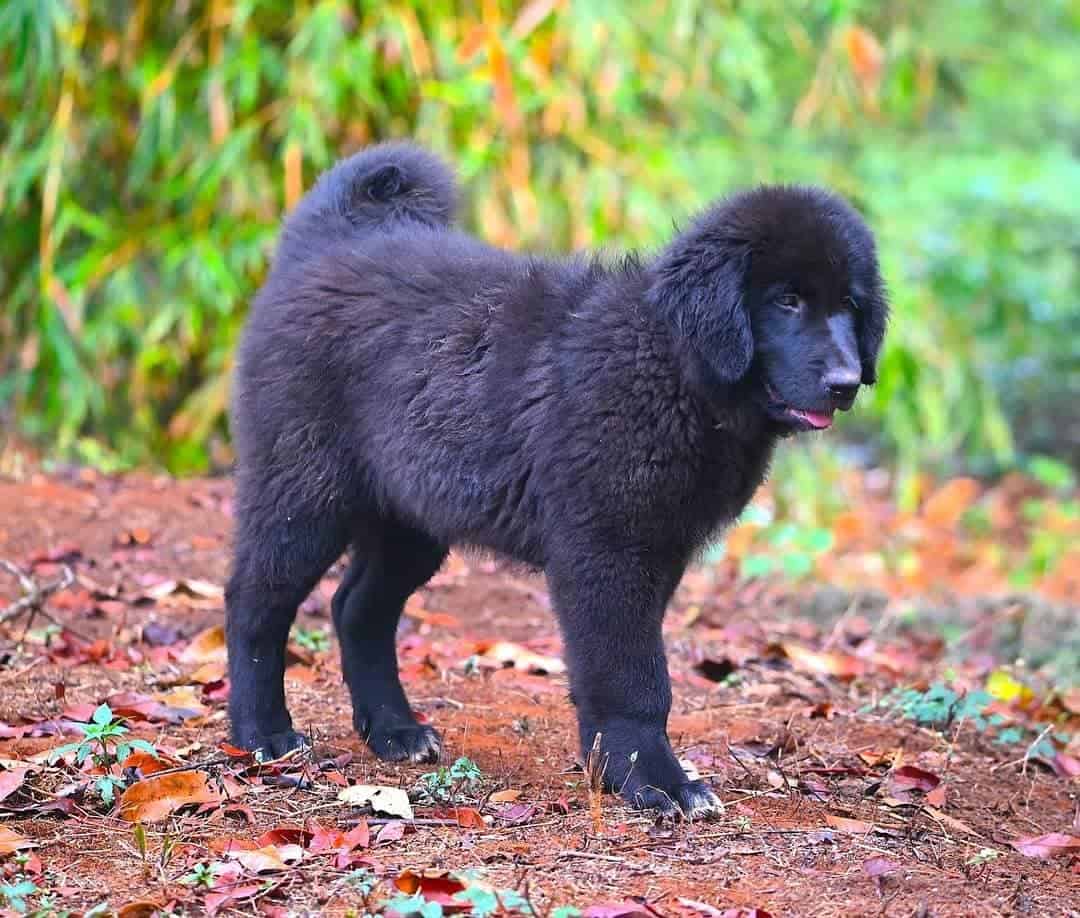
Photo from: @bakharwal_dog_kennel
There’s only one word for the Bakharwal dog breed, and it is “FLAWLESS”. At first sight, the Bakharwal’s size is similar to the Newfoundland dog. It also inherits similar features.
Although they are similar dog breeds, the Bakharwal differs from the Newfoundland dog in many appearance and personality traits.
History
The Bakharwal is an ancient breed that first showed up in the Himalayan mountains. However, recent research is more specific, and it shows that the Bakharwal dog originates from the Kashmir state.
Appearance
The Bakharwal dog is a large, powerful dog, with a heavy bone structure. It is a strong and agile breed – a typical mountain dog with a furry coat and a fluffy, curled up tail that gives it a majestic appearance.
These incredible dogs inherit a double coat that is so dense that they are incredibly difficult to maintain. But, regular brushing goes a long way!
The Bakharwal dog’s fluffy black coat comes with white markings that are usually found across its chest and on its paws. Other coat colors include red, sable, white, black and tan, red, brindle, and fawn.
The Bakharwal dog is huge! Due to its size, it is prone to health problems like canine hip dysplasia and bloat.
Temperament
Bakharwal dogs have been working dogs. But, they have also shown incredible herding skills, which made them both herding dogs and guardians. And, trust me – even nowadays, these dogs take their responsibilities seriously.
Besides its original breeding purpose and strong work ethics, the Bakharwal dog is a gentle giant that gets along well with family members of all ages — they are especially affectionate and kind to children.
However, these dogs have a reputation for being aggressively territorial towards other animals, particularly other dogs.
17. Gull Terrier
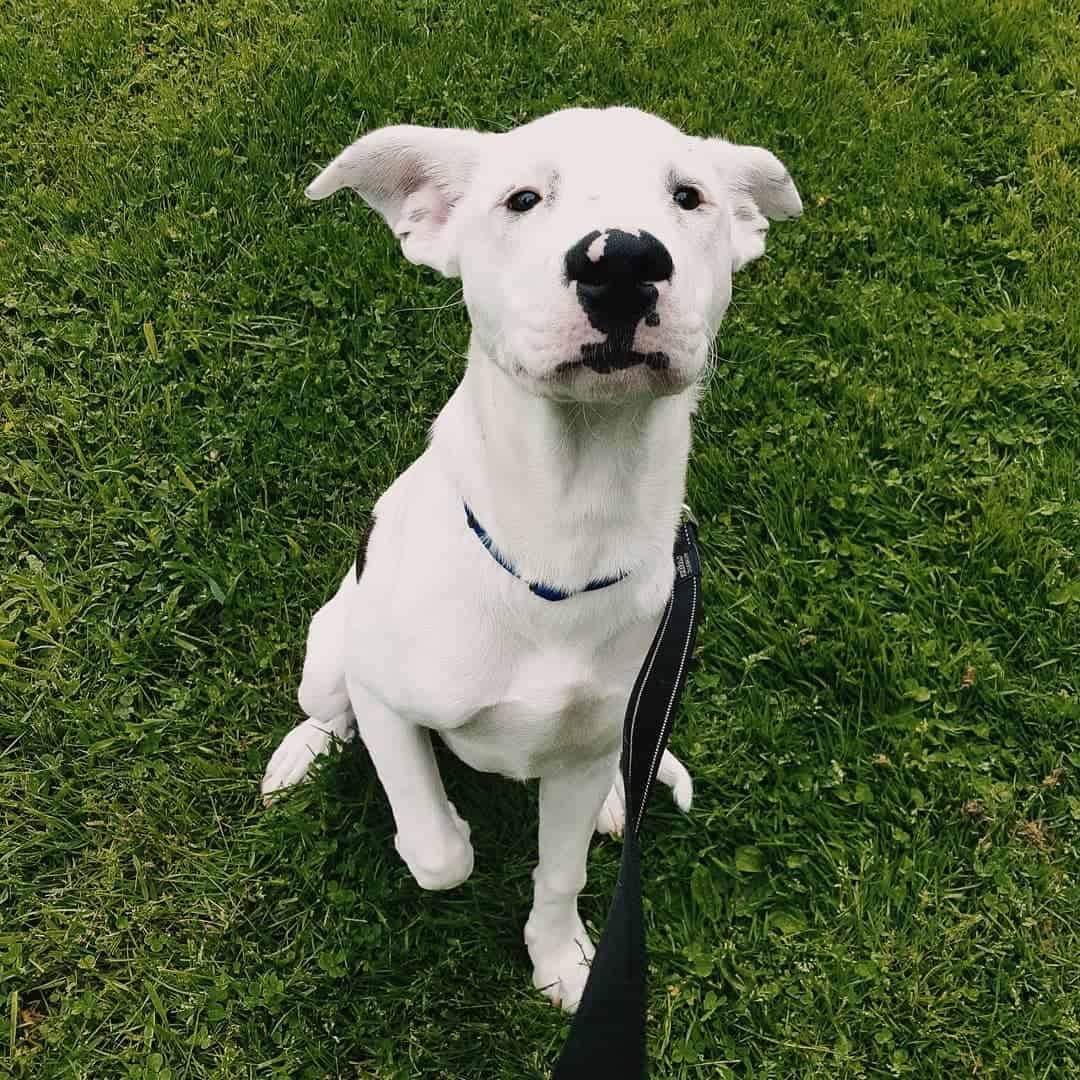
Photo from: @bo.theterrier
Due to the fact that Gull Terriers are quite rare across America, they may be available at trustworthy breeders.
History
The Gull Terrier is a rare breed of dog that is categorized within the Molosser dog group. It is believed to originate from Pakistan and India’s Punjab region.
It is thought to be several hundred years old. Unfortunately, Gull Terriers were used as pit dogs in dog fighting, which is by no means a humane breeding purpose. As time went by, breeders trained Gull Terriers to be excellent herding and guard dogs.
Appearance
The Gull Terrier is not your average small guard dog breed.
Gull Terriers are tall, broad-chested, medium-sized pooches with a short coat. Their ears are large and pointed upwards. Their appearance is almost the same as a Bull Terrier’s! Because of this similarity, Gull Terriers are often called Pakistani Bull Terriers.
Their coat is usually white, but they may have dark markings on their face and body.
Read More: The Pakistani Bully Dog Price: How Much Does It Really Cost?
Temperament
Gull Terriers are extremely loyal to their human pack. They are very intelligent and alert, which makes training sessions relatively easy.
When trained and socialized properly, Gull Terriers get along perfectly with children. However, these dogs should never be left unsupervised around strangers.
Although this dog is not among the aggressive dog breeds, the Gull Terrier might show signs of aggression if it’s not used to new people. It barks a lot, and even tries to attack people it hasn’t met before because it thinks that they are a threat to its owner.
Socialize this breed from a young age to make it easier to manage as it grows. They should not be left alone with other pets.
18. Mahratta Greyhound
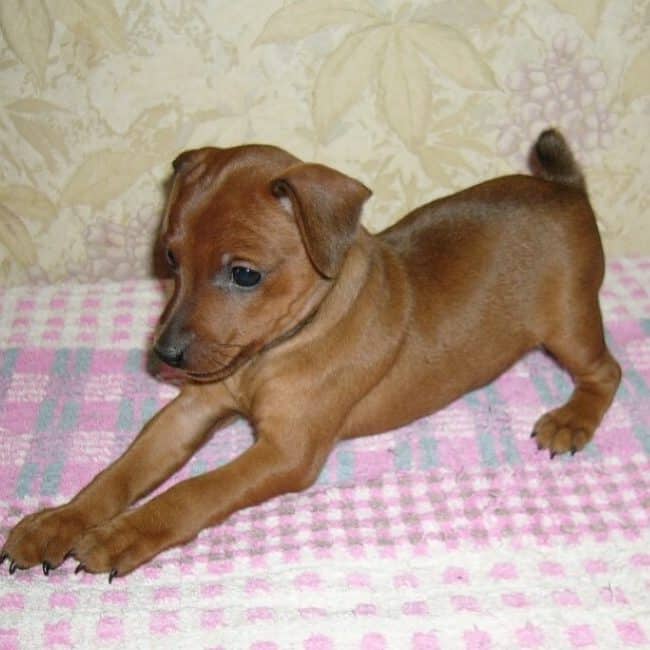
Photo from: @dogandpuppybreeds
The Mahratta is an Indian dog breed that will leave you breathless! With its remarkable looks, this rare breed of dog turns heads!
It’s quite difficult to find it anywhere outside of India, but perhaps there are some paw lovers that may have information about where to get it in the U.S.
History
The Mahratta Greyhound is a breed that originated in the Mahratta province of Maharashtra.
But, like most of the Indian dog breeds on this list, its origin is not entirely looked into.
Appearance
The Mahratta is a rare Indian dog breed that is compact, well-muscled, deep-seated, and strong-backed. It is smooth-coated, and it has high speed as well as active strength.
Temperament
The Mahratta Greyhound has a fast pace and concentrated energy, making it an excellent coursing dog. Mahratta Greyhound owners find it difficult to keep up with its super-fast lifestyle! This athletic pooch needs a lot of space and time to stretch its lean legs.
In terms of intelligence, the Mahratta Greyhound ranks among the smartest dog breeds.
Due to the fact that this dog breed is not so popular, many are not aware that the Mahratta Greyhound has insane levels of intelligence. They understand and remember new commands after just 15 to 20 repetitions.
The Mahratta Greyhound is prone to barking and nipping to let you know that it wants to play. Some might describe it as a needy dog.
19. Jonangi
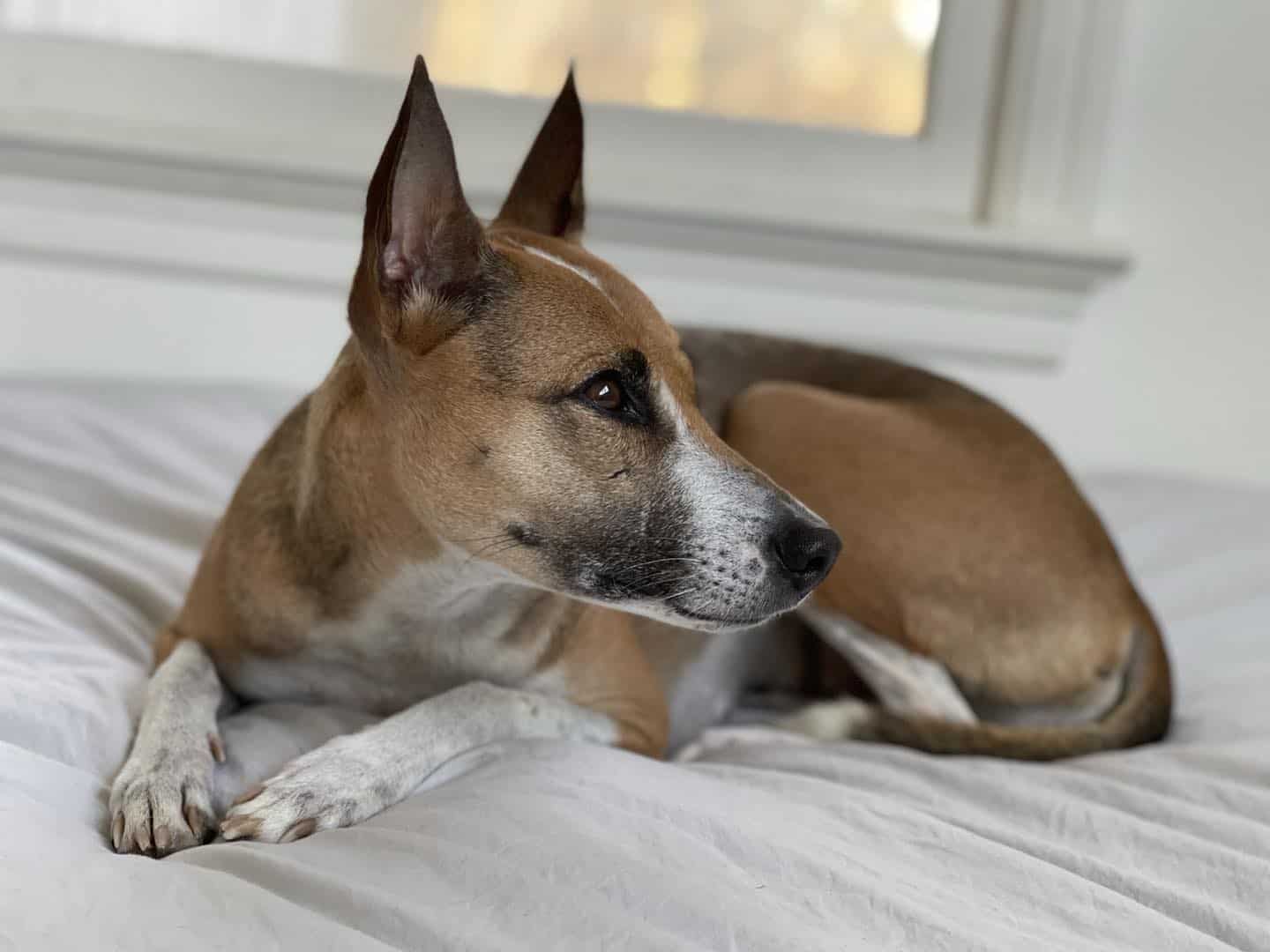
Photo from: @goddess_matsya
The Jonangi is a unique pooch with an exceptional personality. Its pawesome personality is followed by fabulous looks that make it stand out among other Indian dog breeds.
Let’s see what’s so special about the Jonangi dog breed.
History
No one is quite sure where Jonangi dogs exactly originate from. But, it is widely believed that they are from Andhra Pradesh and the Karnataka regions. Out of all Indian dog breeds, the Jonangi dog was bred for a special purpose — to herd ducks!
Interestingly, Jonangi dogs were trained to migrate with birds, herding them and protecting them from predators. They were also used for hunting other animals and herding livestock.
Appearance
The Jonangi, also known as “Kolleti Jagilam”, resembles Bull Terriers with its pricked, upward-facing ears, and it can grow to be just as muscular.
The Jonangi dog is medium-sized, and it has a stocky face with a short muzzle and a wrinkled forehead. Jonangis have a long tail that falls down their back and has a slight curve at its pointy edge. A Jonangi’s short, but dense fur coat is smooth and glossy, preventing the dog from overheating.
Now, get ready for this.
Jonangi dogs are known for being barkless! And, what other dog is known for this specific trait? The Basenji, of course! Instead of barking, Jonangi dogs howl and yodel to alarm everyone.
Temperament
The Jonangi is a one-man dog. It is a fast learner, and it requires a lot of mental stimulation. Additionally, Jonangi dogs can only grow into well-behaved adult dogs if they are introduced to early socialization from as early as eight weeks of age.
Positive reinforcement works wonders with the Jonangi dog. As long as you have yummy treats, this guard dog will obey every command and learn every trick!
Jonangis have so much potential, and when they are in good hands, they make amazing family pets and get along well with children.
20. Tangkhul
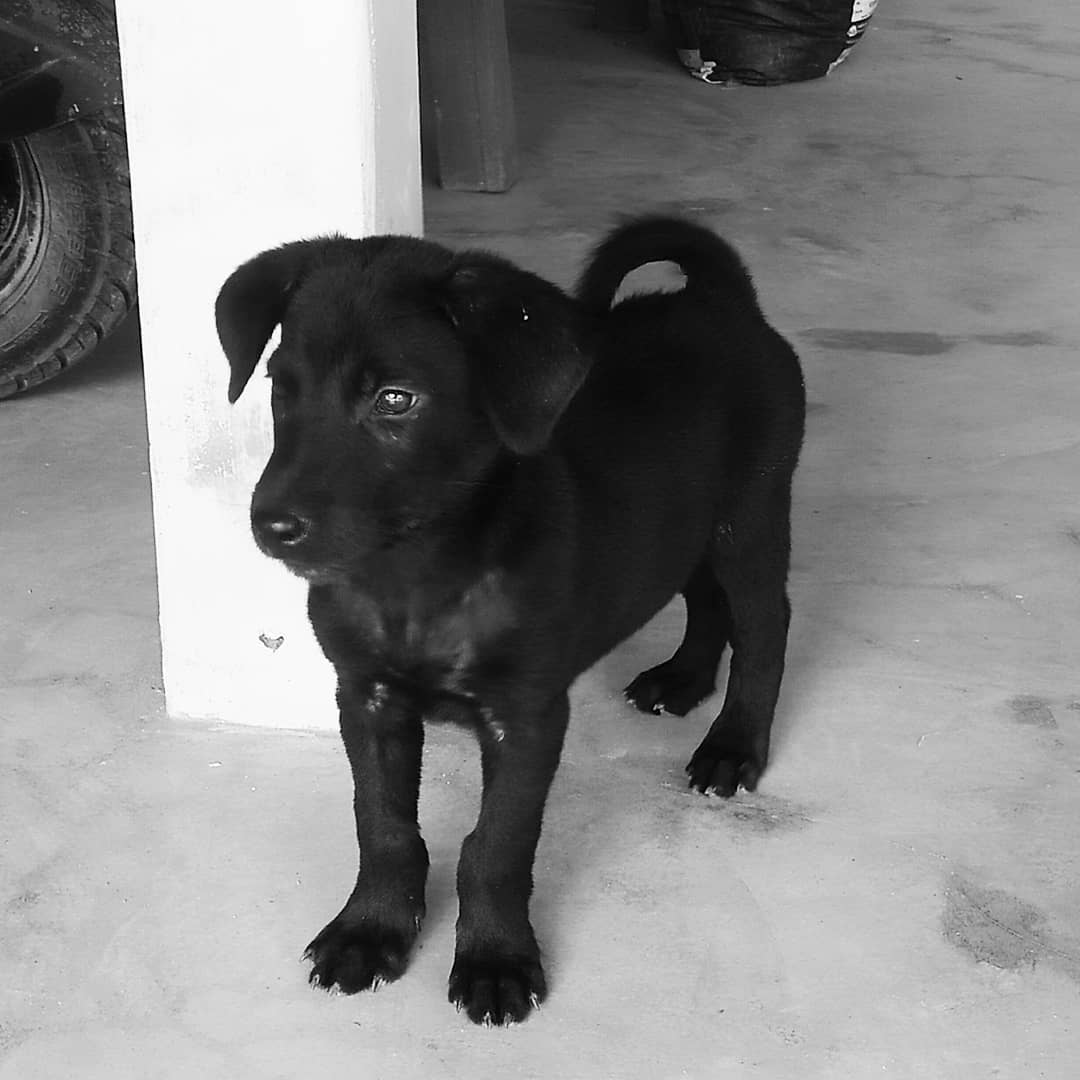
Photo from: @_miss_pet_
The Tangkhul Hui is a hunting dog found in the Indian state of the Manipur Ukhrul District. It is a very rare dog breed that evolved centuries ago, possibly through a mix of Myanmar dog breeds near the Indo-Burma border. It focused on hunting wild boar and other wild animals in and around jungle areas.
Appearance
They are generally very dark brown/black in color, with pricked ears, a short, curled bob tail, and a wide face with a pointed nose. Because of the hot weather, most have a very short coat, but there are some with a longer coat.
Temperament
The Tangkhul Hui is an extremely intelligent, obedient, and fierce dog. This breed is quick to learn and friendly to family members, but aloof to strangers.
21. Sinhala Hound
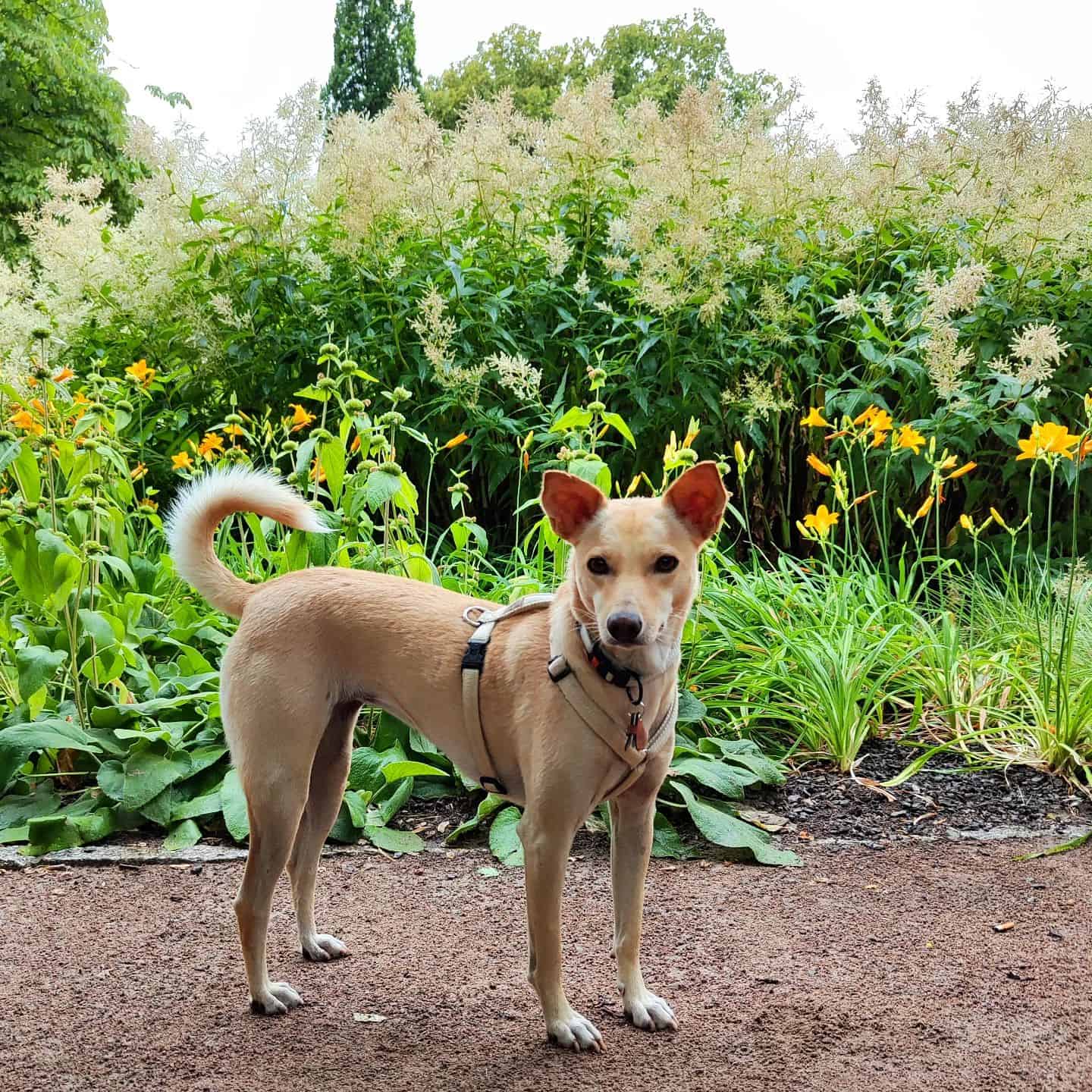
Photo from: @modusmaja
The Sinhala is a noble Indian dog that has a very unique history behind it. According to local legend, when Prince Vijaya arrived in Sri Lanka in the sixth century BC, he was greeted by the barking of dogs, which later turned out to be Sinhala Hounds.
History
The Sinhala Hound, also known as the Sinhalese Hound, is a dog breed that is native to Sri Lanka and parts of India.
Dog skeletons discovered in the Nilgala cave and Bellanbandi Palassa dating from the Mesolithic era (around 4,500 BC) suggest that Balangoda Man kept domestic dogs for hunting.
Appearance
The Sinhala Hound comes in a variety of colors, but the most common are brown or dark brown brindles.
They resemble the African Basenji, the New Guinea Singing Dog, the Carolina Dog, and the Australian Dingo in appearance.
Temperament
The Vedda people frequently used the Sinhala Hound for hunting, most likely due to its alert, watchful, amiable, and obedient nature, as well as its keen scenting ability.
22. Gull Dong
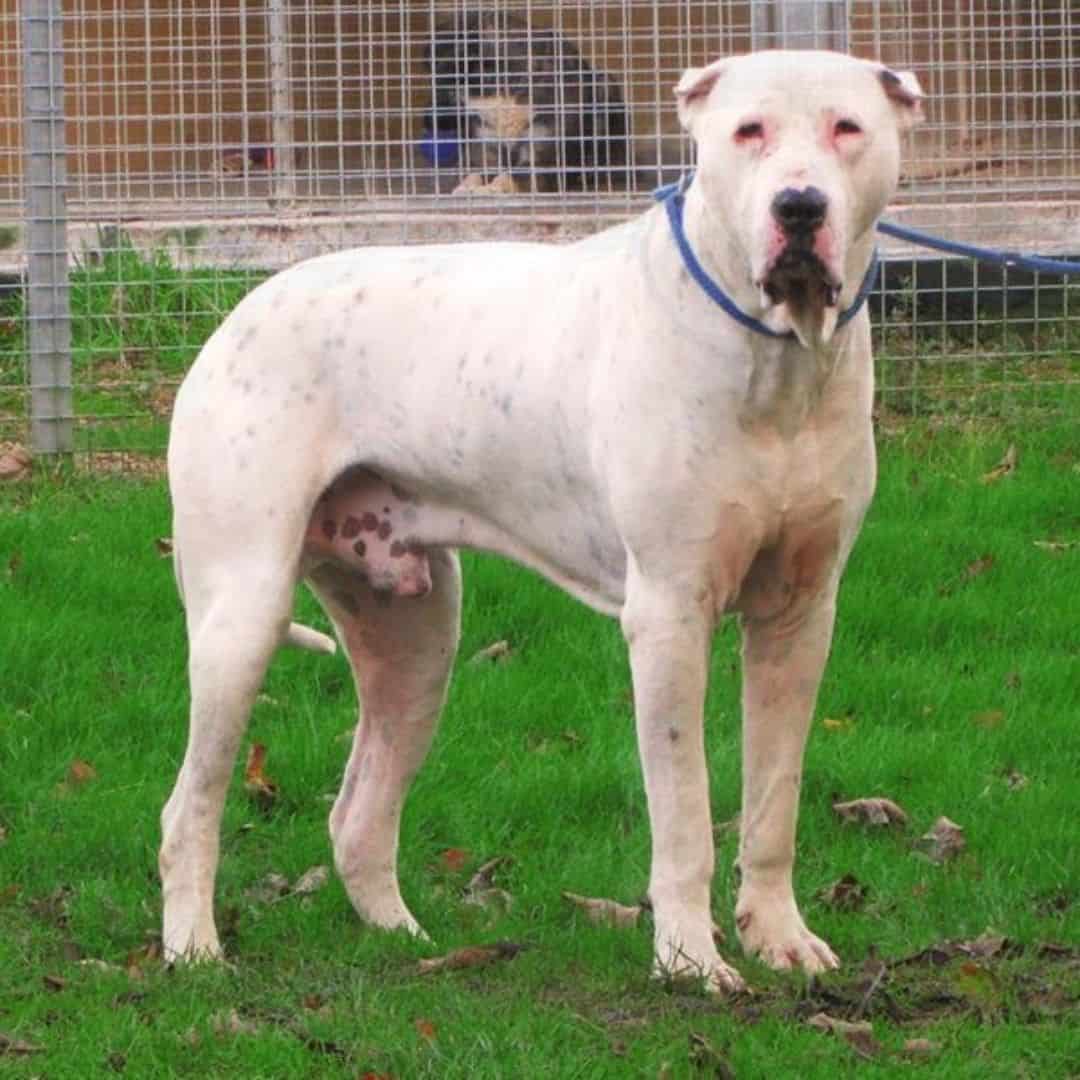
Photo from: @petdog075
History
The Gull Dong is the offspring of a Gull Terrier and a Bully Kutta. These were first crossed in colonial India, and the resulting Gull Dong is revered in both India and Pakistan for its “speed and tenacity.”
Appearance
The Gull Dong stands taller than most Pakistani breeds, and it can weigh up to 140 pounds. Gull Dongs usually inherit a white, short coat, just like that of the Dogo Argentino breed. But, they can also come in brindle, black, or gray.
The Gull Dong’s head and small eyes are its distinguishable features. Its head is broad, with wide and powerful jaws. This dog is muscular, with a sloping back and a deep, wide chest.
Comparison wise, the Gull Dong is very similar to big, intimidating dog breeds, such as the Cane Corso and the Dogo Argentino.
Temperament
The Gull Dong is a loyal and intelligent dog that tends to be very strong-willed and stubborn.
The Gull Dong is a strong and powerful dog that should be trained and socialized at a very young age. If an owner is having second guesses about his Gull Dong’s behavior, it is not a smart idea to leave it unsupervised around children.
Gull Dongs are known for their strong work ethics, but not for their bubbly and affectionate side. Although they will display cuddly behavior towards their owner, Gull Dongs can get very anxious around loud children.
This is why a Gull Dong puppy requires an experienced dog owner who will put a lot of effort into early socialization and obedience training.
Conclusion
Wow, these are some brave, fearless, affectionate, and loyal native Indian dog breeds! Due to the fact that most of these dogs are not available in the U.S., we can only admire their majestic looks and remarkable personalities.
Most of the popular western dog breeds like Labrador Retrievers, German Shepherds, and Poodles are taking the Indian dog market by storm.
This is why, unfortunately, many Indian dog breeds are threatened by extinction because Indian breeders are not entirely focused on breeding these native dogs.
Many of these wonderful dogs are quite underrated, and most deserve more popularity and recognition because they are such good dogs!
Related Content
40 Basset Hound Mixes You Need To Know About
